文章
lenny
2017年05月23日
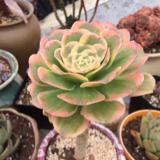
Growing Banana trees in pots is easy, if you’re unable to grow it on the ground either due to lack of space or cold climate. Learn how to grow banana trees in this complete article.
There are banana varieties that can withstand temperature drops and grows well in containers, popular especially among the fans of exotic tropical plants in the garden.
The first question that may come up in your mind is– Will banana tree in a pot can bear fruits?
And the answer is yes. It is possible, a banana tree bears fruits in pot prolifically. It may take up to 3 to 5 years to fruit if grown from seeds.
Growing Banana Trees in Pots
Banana is a lush green, fast-growing plant that can give any place a tropical look and feel. Many varieties become excellent houseplants that don’t need much care and grow up very quickly.
Dwarf varieties of banana trees can grow anywhere between 2 to 4 meters. Compared to the ordinary banana trees that can reach up to 15 meters high.
Growing Banana Trees in Pots in Tropics
Growing banana tree in pot in a tropical climate is extremely easy, with little to no care banana tree grows in the container. If you’re living under USDA Zones 9 to 11, keep your banana tree in the shade in afternoon in summer, when the plant is young. All the other requirements are similar as given below in the article for temperate zones.
Banana Varieties you can Grow in Pots and Indoors
These dwarf varieties of banana tree restrict up to only 1.5 m to 4 m. (4 to 12 feet) tall and are suitable to grow in containers. You can also grow these banana varieties indoors.
Dwarf RedDwarf CavendishDwarf BrazilianDwarf JamaicanRajapuriWilliams HybridGran NainDwarf ‘Lady Finger’
If you would like to grow ornamental bananas check out these varieties:
Ensete ventricosumMusa sikkimensis ‘Red Tiger’Musa ornata
Also read: How to grow lemon in Pots
Requirements for Growing Banana Trees in PotsSun
Banana trees grow in tropical and subtropical parts of the world and therefore they love full sun, heat and humidity. If you’re growing banana tree you should keep it in a spot that receives the sun most of the day but preferably sheltered from the wind.
Soil
Growing Banana tree requires well-draining soil, sandy soil that is rich in organic matters and compost. Buy a good quality potting mix for your banana tree. If you are making it at home make sure to mix sand, perlite, and compost or manure.
Banana needs slightly acidic to neutral soil to produce those potassium rich nutritious bananas. The soil pH should be around 6 – 7. If your soil is alkaline mix sulfur to decrease the pH.
Watering
Banana loves moisture. Water it regularly and deeply but care not to overwater. In summer, water it every day. It may need water even two times a day in hot weather or when it is root bound. Soil for growing banana plants should be kept uniformly moist. Reduce watering in winter.
Banana Plant in Pot Care
Humidity
Banana plant prefers humidity levels above 50%. To increase humidity level around the plant, mist the plant and place it on a layer of pebbles in a tray filled with water.
Overwintering Banana Tree
Banana plants stop growing when the temperature drops below 50 ° Fahrenheit.
Before the onset of winter, do heavy mulching and prune the leaves.
Put it in a warm, bright room till the spring.
Fertilizer
Banana is a fast growing plant and it requires heavy feeding to grow at its full strength. Fertilize young plant when it establishes well with nitrogen-rich fertilizer to help it grow faster. Once your banana tree in pot becomes mature enough to produce fruit, fertilize it with 15:5:30 fertilizer regularly.
Pests and diseases
Bananas are quite resistant to diseases, still when you see the leaves turning brown and drying at the edges it means you’re overwatering and if the leaves turn yellow, banana plant is having a lack of nutrients.
Some pests that might attack banana plant are banana aphids, banana weevil, and coconut scale. These pests can easily be repelled using organic pesticides.

There are banana varieties that can withstand temperature drops and grows well in containers, popular especially among the fans of exotic tropical plants in the garden.
The first question that may come up in your mind is– Will banana tree in a pot can bear fruits?
And the answer is yes. It is possible, a banana tree bears fruits in pot prolifically. It may take up to 3 to 5 years to fruit if grown from seeds.
Growing Banana Trees in Pots
Banana is a lush green, fast-growing plant that can give any place a tropical look and feel. Many varieties become excellent houseplants that don’t need much care and grow up very quickly.
Dwarf varieties of banana trees can grow anywhere between 2 to 4 meters. Compared to the ordinary banana trees that can reach up to 15 meters high.
Growing Banana Trees in Pots in Tropics
Growing banana tree in pot in a tropical climate is extremely easy, with little to no care banana tree grows in the container. If you’re living under USDA Zones 9 to 11, keep your banana tree in the shade in afternoon in summer, when the plant is young. All the other requirements are similar as given below in the article for temperate zones.
Banana Varieties you can Grow in Pots and Indoors

These dwarf varieties of banana tree restrict up to only 1.5 m to 4 m. (4 to 12 feet) tall and are suitable to grow in containers. You can also grow these banana varieties indoors.
Dwarf RedDwarf CavendishDwarf BrazilianDwarf JamaicanRajapuriWilliams HybridGran NainDwarf ‘Lady Finger’
If you would like to grow ornamental bananas check out these varieties:
Ensete ventricosumMusa sikkimensis ‘Red Tiger’Musa ornata
Also read: How to grow lemon in Pots
Requirements for Growing Banana Trees in PotsSun
Banana trees grow in tropical and subtropical parts of the world and therefore they love full sun, heat and humidity. If you’re growing banana tree you should keep it in a spot that receives the sun most of the day but preferably sheltered from the wind.
Soil
Growing Banana tree requires well-draining soil, sandy soil that is rich in organic matters and compost. Buy a good quality potting mix for your banana tree. If you are making it at home make sure to mix sand, perlite, and compost or manure.
Banana needs slightly acidic to neutral soil to produce those potassium rich nutritious bananas. The soil pH should be around 6 – 7. If your soil is alkaline mix sulfur to decrease the pH.
Watering
Banana loves moisture. Water it regularly and deeply but care not to overwater. In summer, water it every day. It may need water even two times a day in hot weather or when it is root bound. Soil for growing banana plants should be kept uniformly moist. Reduce watering in winter.
Banana Plant in Pot Care

Humidity
Banana plant prefers humidity levels above 50%. To increase humidity level around the plant, mist the plant and place it on a layer of pebbles in a tray filled with water.
Overwintering Banana Tree
Banana plants stop growing when the temperature drops below 50 ° Fahrenheit.
Before the onset of winter, do heavy mulching and prune the leaves.
Put it in a warm, bright room till the spring.
Fertilizer
Banana is a fast growing plant and it requires heavy feeding to grow at its full strength. Fertilize young plant when it establishes well with nitrogen-rich fertilizer to help it grow faster. Once your banana tree in pot becomes mature enough to produce fruit, fertilize it with 15:5:30 fertilizer regularly.
Pests and diseases
Bananas are quite resistant to diseases, still when you see the leaves turning brown and drying at the edges it means you’re overwatering and if the leaves turn yellow, banana plant is having a lack of nutrients.
Some pests that might attack banana plant are banana aphids, banana weevil, and coconut scale. These pests can easily be repelled using organic pesticides.
4
2
文章
扭扭
2017年05月23日

Learn how to grow cucumbers vertically to get the most productive plant. Growing cucumbers vertically also save lot of space, which is suitable for small gardens.
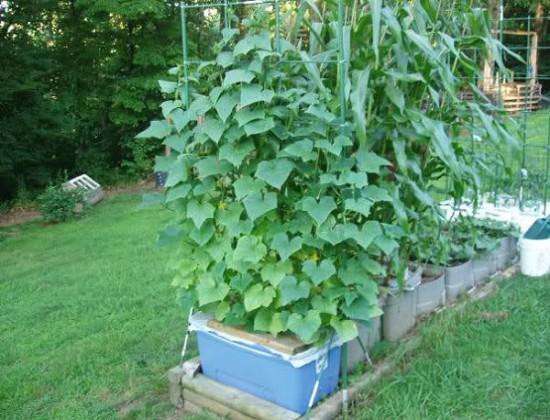
Cucumber is a refreshing vegetable, especially if picked up fresh. It is eaten in variety of ways: raw in salad, cooked or pickled. It is easy to grow and only requires a warm, sunny exposure and deep and regular watering.
What if you want to grow cucumbers but you have a small garden. Definitely, it will take a lot of space. In that case growing cucumbers vertically is an space savvy option.
Benefits of Growing Cucumbers Vertically
One advantage of Growing Cucumbers Vertically is that by this you can avoid a common problem of fruit rot associated with cucumber cultivation, which happens when fruit sitting in moist soil for long period of time. When you allow cucumber vines to grow up vertically, it improves the air circulation around the plant that prevents fungal diseases. Cucumber plants have sprawling habit and growing cucumbers vertically allow their leaves to absorb more sun, which result in healthy plant and large cucumbers. One more key benefit is that you can harvest the fruits more easily and in time.
Why you should grow cucumbers vertically
When cucumbers grown horizontally they usually cover 10 – 20 sq ft of space, plant sprawls over the surface around it. However, smaller and bushier varieties take only 1/3 of this space but they produce less fruits. Climbing, vine type varieties are more productive and when you grow them vertically they barely take 1 sq ft of space, climbing up on the support of trellis.
How to Grow Cucumbers VerticallyChoosing Container and Trellis
If you’re growing cucumbers vertically in containers, prefer large containers that are about at least 12 inches deep and wide. How many cucumber plants you can grow in such a container depends on the variety you are planting. A vining variety grows tall and send long roots, whereas bushier varieties are short.
Trellis Size
Choose a 5 to 6 feet tall trellis that is sturdy and doesn’t topple. If growing climbing varieties use “A frame trellis” so that the plant crawl up and down from it easily.
Propagation and Planting Cucumbers
Sow seeds directly onto the desired spot or in small pots. Cover them with about 2 cm of soil. Once the seedlings germinate and have a few leaves, transplant the healthiest ones into a bigger pot or on the frost free ground in spring or summer when soil temperature is around 70 F (20 C). If you live in tropical or subtropical climate, you can grow cucumber year round.
Cucumber plant is a heavy feeder like tomatoes, prepare your soil well before planting by incorporating decomposed manure and compost.
Requirements for Growing Cucumbers VerticallyPosition
Cucumber loves a warm and sunny exposure that is less windy. It does not tolerate temperature below 50 F (10 C). Optimum temperature to grow cucumbers fall in the range of 60 – 95 F (15 – 35 C).
Soil
It prefers well drained, loose and deep soil, rich in organic matter and neutral in pH.
Watering
Regular and deep watering is the key of productive harvest, when growing cucumber. It is due to the high water content of its fruits. While watering, avoid wetting the foliage as it may encourage fungal diseases.
Mulching
Mulch around the base of plant to improve moisture retaining ability of soil.
Fertilizer
At the time of planting add all purpose slow release fertilizer in soil. Once the plant starts to flower, side dress the plant with aged manure. Also apply balanced liquid fertilizer at that time according to manufacturer’s instructions.
Diseases and Pests
Cucumber plants particularly suffer from anthracnose, powdery mildew and in pests look out for aphids.
HarvestWhen and how to harvest cucumbers?
Cucumbers are ready for harvest in 60 to 90 days after seed sowing, depending on the variety. Pick cucumbers when they are developed enough, do not
let the fruit to overripe.

Cucumber is a refreshing vegetable, especially if picked up fresh. It is eaten in variety of ways: raw in salad, cooked or pickled. It is easy to grow and only requires a warm, sunny exposure and deep and regular watering.
What if you want to grow cucumbers but you have a small garden. Definitely, it will take a lot of space. In that case growing cucumbers vertically is an space savvy option.
Benefits of Growing Cucumbers Vertically
One advantage of Growing Cucumbers Vertically is that by this you can avoid a common problem of fruit rot associated with cucumber cultivation, which happens when fruit sitting in moist soil for long period of time. When you allow cucumber vines to grow up vertically, it improves the air circulation around the plant that prevents fungal diseases. Cucumber plants have sprawling habit and growing cucumbers vertically allow their leaves to absorb more sun, which result in healthy plant and large cucumbers. One more key benefit is that you can harvest the fruits more easily and in time.
Why you should grow cucumbers vertically
When cucumbers grown horizontally they usually cover 10 – 20 sq ft of space, plant sprawls over the surface around it. However, smaller and bushier varieties take only 1/3 of this space but they produce less fruits. Climbing, vine type varieties are more productive and when you grow them vertically they barely take 1 sq ft of space, climbing up on the support of trellis.
How to Grow Cucumbers VerticallyChoosing Container and Trellis

If you’re growing cucumbers vertically in containers, prefer large containers that are about at least 12 inches deep and wide. How many cucumber plants you can grow in such a container depends on the variety you are planting. A vining variety grows tall and send long roots, whereas bushier varieties are short.
Trellis Size
Choose a 5 to 6 feet tall trellis that is sturdy and doesn’t topple. If growing climbing varieties use “A frame trellis” so that the plant crawl up and down from it easily.
Propagation and Planting Cucumbers
Sow seeds directly onto the desired spot or in small pots. Cover them with about 2 cm of soil. Once the seedlings germinate and have a few leaves, transplant the healthiest ones into a bigger pot or on the frost free ground in spring or summer when soil temperature is around 70 F (20 C). If you live in tropical or subtropical climate, you can grow cucumber year round.
Cucumber plant is a heavy feeder like tomatoes, prepare your soil well before planting by incorporating decomposed manure and compost.
Requirements for Growing Cucumbers VerticallyPosition
Cucumber loves a warm and sunny exposure that is less windy. It does not tolerate temperature below 50 F (10 C). Optimum temperature to grow cucumbers fall in the range of 60 – 95 F (15 – 35 C).
Soil
It prefers well drained, loose and deep soil, rich in organic matter and neutral in pH.
Watering
Regular and deep watering is the key of productive harvest, when growing cucumber. It is due to the high water content of its fruits. While watering, avoid wetting the foliage as it may encourage fungal diseases.
Mulching
Mulch around the base of plant to improve moisture retaining ability of soil.
Fertilizer
At the time of planting add all purpose slow release fertilizer in soil. Once the plant starts to flower, side dress the plant with aged manure. Also apply balanced liquid fertilizer at that time according to manufacturer’s instructions.
Diseases and Pests
Cucumber plants particularly suffer from anthracnose, powdery mildew and in pests look out for aphids.
HarvestWhen and how to harvest cucumbers?
Cucumbers are ready for harvest in 60 to 90 days after seed sowing, depending on the variety. Pick cucumbers when they are developed enough, do not
let the fruit to overripe.
1
0
文章
扭扭
2017年05月23日

Indoor gardening can be a challenge if you’re short of space. And, for your help here’re the 15 Brilliant Vertical Indoor Garden Ideas, by applying a few of these you’ll be able to create more space!1. Vertical Pallet Planter
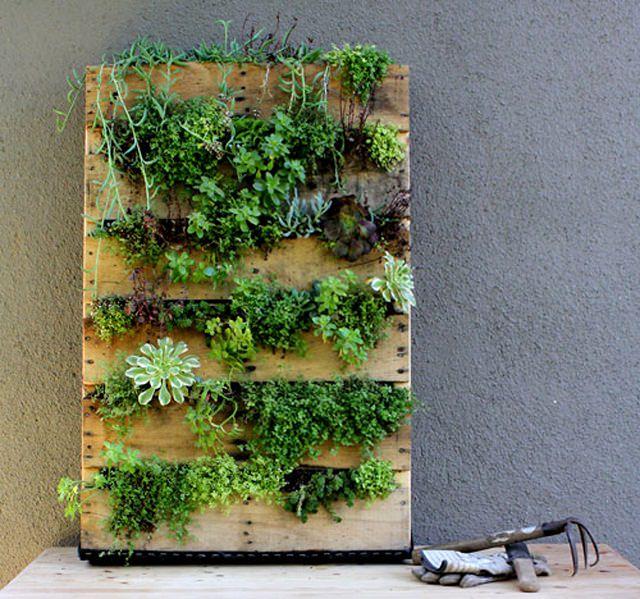
Make a vertical pallet planter to create an adorable indoor garden easily and inexpensively. They’ll provide enough space for growing herbs and succulents without taking a much of floor space. Check out how to make one.
2. Dresser Planter

A bit quirky idea! Use an old dresser to create a stunning indoor garden. Plant some ferns and succulents in its drawers and also place some on top to create a beautiful indoor garden.
3. Indoor Ladder Planter

Previously we wrote a lot about the use of ladder planter in a balcony or rooftop garden. A practical idea! You can apply it to your indoor garden too! An old ladder is perfect to grow multiple house plants in limited space. To make this, simply add several wood planks on ladder steps to create shelves. Then plants your houseplants on it but be sure to place houseplants that have similar light requirements. Here is more on it.
4. DIY Pot Hanger
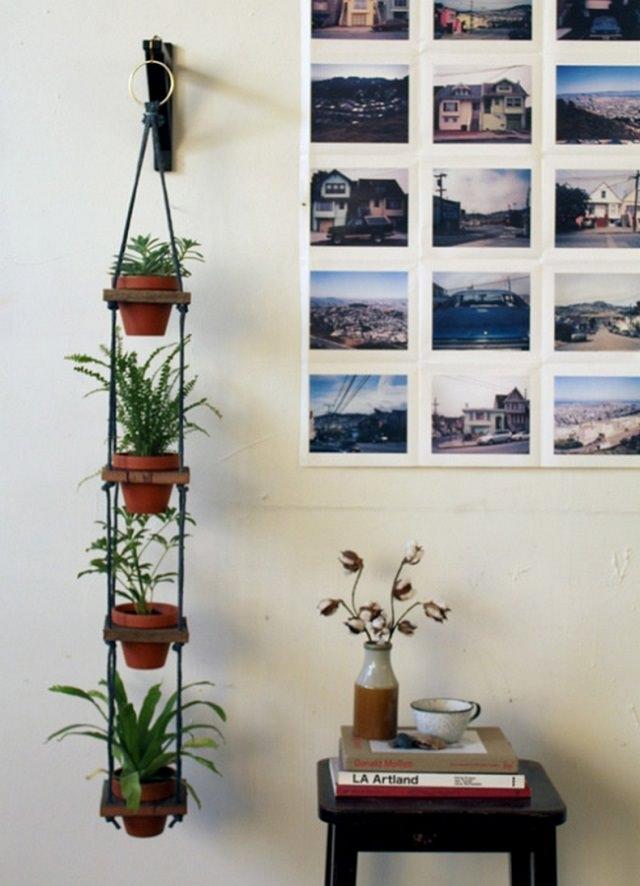
A unique (or say bizarre) way to display your favorite houseplants. This easy project only requires some scrap wood, rope, and a few basic woodworking tools. The best part is that the system makes watering a breeze. All the runoff from the previous pot drips into the plants below, so you only need to water the plant on top and be sure place a saucer under the bottom most pot. Here is the tutorial.
5. TV Stand Vertical Garden
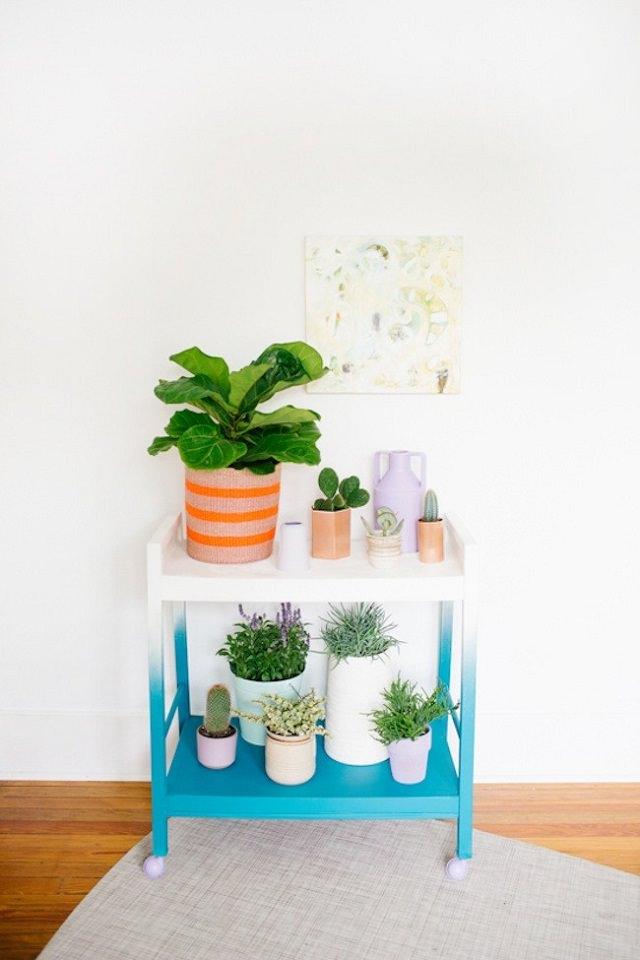
Got an old TV Stand? Make a vertical indoor garden out of it. This is a great way to recycle your old TV stand and transform it to a living beauty. You can either paint it for a fresh new look or use it as it is for a rustic look.
6. Hanging Plastic Bottle Cactus Garden
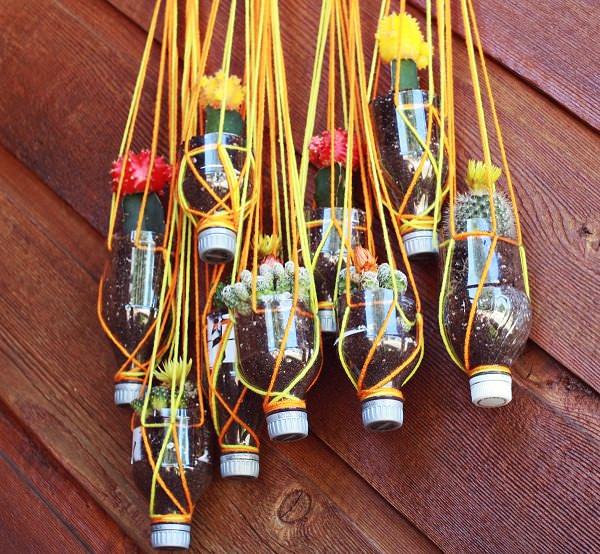
Do you want to create a vertical soda bottle garden? Follow this idea. All that is required is bottles cut in half, cactus plants or succulents, and many colorful threads to get a really cool decorative look. Here you can see the complete tutorial.
7. Shoe Organizer Vertical Garden
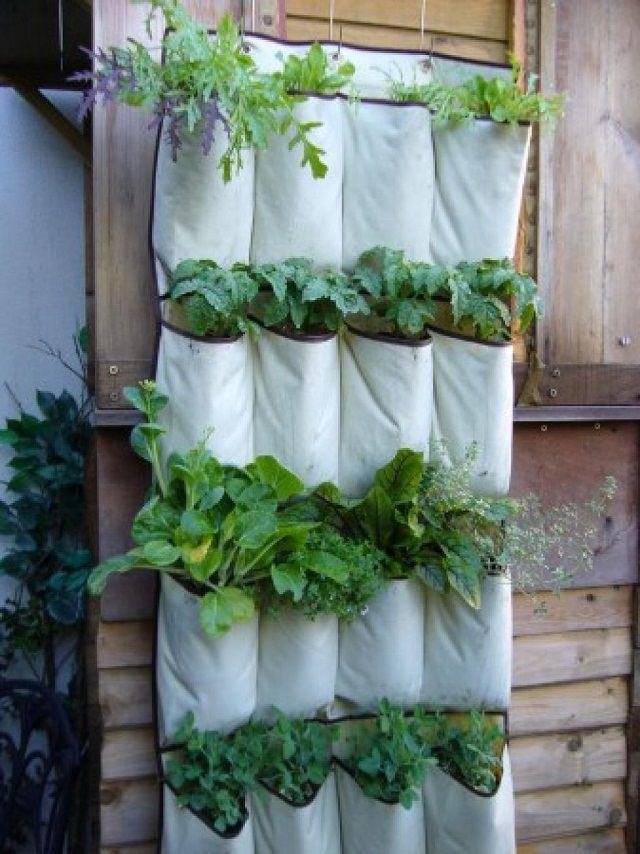
A hanging shoe organizer is perfect for your vertical INDOOR garden. Its pockets are the ideal size for growing individual plants and herbs. Get the DIY instructions here.
8. Vertical Herb Garden

Want to grow herbs but you don’t have space (short of budget too)? Well, even a wooden plank is enough. All you need is some plastic bottles, hooks, nails and hammer and you’re all set to grow your own herbs.
9. Mason Jar Vertical Garden

Don’t throw away those old mason jars, use them creatively to make an indoor herb wall garden. Metal bands and screws hold the jars in place against a scrap piece of wood that is mounted on the wall. Fill in the soil and plant your favorite herbs to use them all year round. Read about more Mason Jar Uses here!
10. Hanging Coconut Planter

Use coconut shells after eating to create this super cute hanging indoor garden. This project is unique, still simple and doesn’t require much. Check out the tutorial here.
11. Pallet Container Holder

Arrange a pallet board and hang several pots on it. It’s easy! And the best part is it will create plenty of vertical space.
12. Vertical Picture Frame Planter
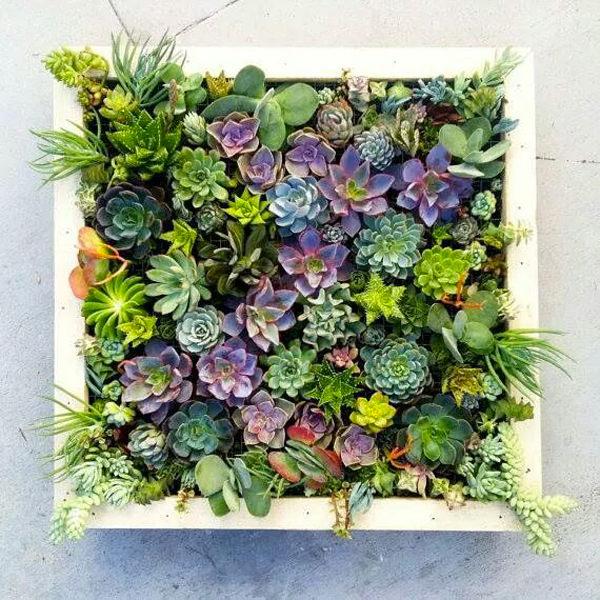
A cool idea for your room if it receives some sun to make it greener, you can hang a wall planter like this in your room. See the step by step tutorial on our website.
13. Vertical Pot Holder From Pallet Planks

Dismantle a pallet board and separate the pallet planks; nail them on to the wall and fix the pots. Simple!
14. Hanging Terracotta Planters

Vertical gardening is a boon for those who’re short of space. A tutorial is available here.
15. Iron Grid Pot Holder
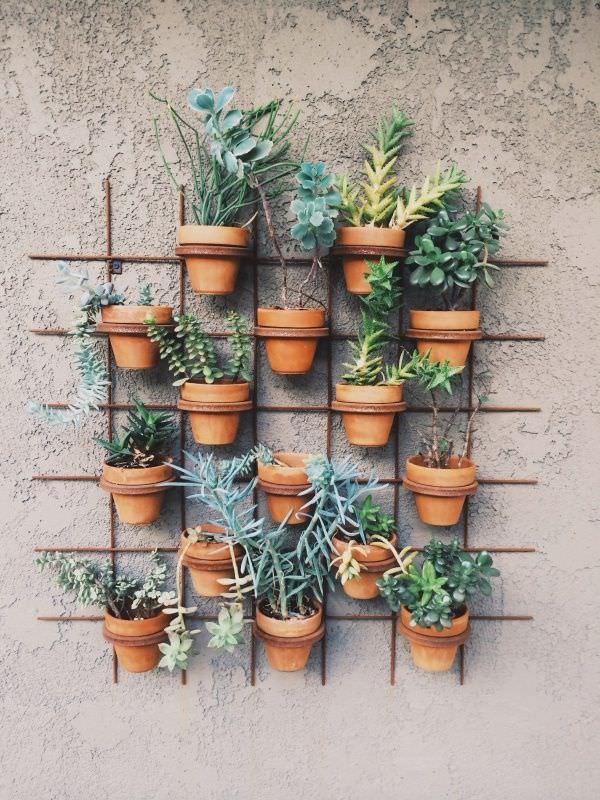
You can make a grid like this by welding the iron rods or weave them by any other method so that you’ll be able to hang the pots. You can paint that too in your favorite color. *The grid can also be made of wood.

Make a vertical pallet planter to create an adorable indoor garden easily and inexpensively. They’ll provide enough space for growing herbs and succulents without taking a much of floor space. Check out how to make one.
2. Dresser Planter

A bit quirky idea! Use an old dresser to create a stunning indoor garden. Plant some ferns and succulents in its drawers and also place some on top to create a beautiful indoor garden.
3. Indoor Ladder Planter

Previously we wrote a lot about the use of ladder planter in a balcony or rooftop garden. A practical idea! You can apply it to your indoor garden too! An old ladder is perfect to grow multiple house plants in limited space. To make this, simply add several wood planks on ladder steps to create shelves. Then plants your houseplants on it but be sure to place houseplants that have similar light requirements. Here is more on it.
4. DIY Pot Hanger

A unique (or say bizarre) way to display your favorite houseplants. This easy project only requires some scrap wood, rope, and a few basic woodworking tools. The best part is that the system makes watering a breeze. All the runoff from the previous pot drips into the plants below, so you only need to water the plant on top and be sure place a saucer under the bottom most pot. Here is the tutorial.
5. TV Stand Vertical Garden

Got an old TV Stand? Make a vertical indoor garden out of it. This is a great way to recycle your old TV stand and transform it to a living beauty. You can either paint it for a fresh new look or use it as it is for a rustic look.
6. Hanging Plastic Bottle Cactus Garden

Do you want to create a vertical soda bottle garden? Follow this idea. All that is required is bottles cut in half, cactus plants or succulents, and many colorful threads to get a really cool decorative look. Here you can see the complete tutorial.
7. Shoe Organizer Vertical Garden

A hanging shoe organizer is perfect for your vertical INDOOR garden. Its pockets are the ideal size for growing individual plants and herbs. Get the DIY instructions here.
8. Vertical Herb Garden

Want to grow herbs but you don’t have space (short of budget too)? Well, even a wooden plank is enough. All you need is some plastic bottles, hooks, nails and hammer and you’re all set to grow your own herbs.
9. Mason Jar Vertical Garden

Don’t throw away those old mason jars, use them creatively to make an indoor herb wall garden. Metal bands and screws hold the jars in place against a scrap piece of wood that is mounted on the wall. Fill in the soil and plant your favorite herbs to use them all year round. Read about more Mason Jar Uses here!
10. Hanging Coconut Planter

Use coconut shells after eating to create this super cute hanging indoor garden. This project is unique, still simple and doesn’t require much. Check out the tutorial here.
11. Pallet Container Holder

Arrange a pallet board and hang several pots on it. It’s easy! And the best part is it will create plenty of vertical space.
12. Vertical Picture Frame Planter

A cool idea for your room if it receives some sun to make it greener, you can hang a wall planter like this in your room. See the step by step tutorial on our website.
13. Vertical Pot Holder From Pallet Planks

Dismantle a pallet board and separate the pallet planks; nail them on to the wall and fix the pots. Simple!
14. Hanging Terracotta Planters

Vertical gardening is a boon for those who’re short of space. A tutorial is available here.
15. Iron Grid Pot Holder

You can make a grid like this by welding the iron rods or weave them by any other method so that you’ll be able to hang the pots. You can paint that too in your favorite color. *The grid can also be made of wood.
1
0
文章
Selina
2017年05月23日

You don’t need a big yard to have a great garden; it is even possible in smallest of space. Take a look!
If you’re looking to exercise your green thumb but don’t have acres of land, have no fear; a great garden can bloom even in the smallest spaces! All it takes are a few creative techniques, and you can be well on your way to flourishing greenery. Read on to find out some strategic ways to cultivate the most out of your space.
Create Levels and Depth

Create more space by making different levels in your personal patch. In simple words, divide your garden into sections! The division will create an illusion of a large garden– It will also make your garden look lively and interesting.
Do this by planting in tiered beds or adding soil mounds. Also, grow large shrubs or small trees wherever the division is intended. For a more organized look, use stones or lines of grass to separate the different sections of your garden. This is a very good idea for small patios or rooftops.
You can also grow grasses in containers, take a look at some of the best ornamental grasses!
Also Read: Watering grass seed
Another way to add space is by growing your plants vertically. Make a living wall or trellis using wire, bamboo or even pockets of netting. Plants like herbs and vines can easily be transplanted here. If you have a column-like structure, you can make a garden tower that grows florals like orchids.
Also Read: Best Vines for Pergolas
Pro Tip: Care for your vertical plants by targeting their roots when you water them. This prevents wastage from the runoff you’d get when watering from the top.
Food is Your Friend

An edible garden gives you great versatility regarding what you can plant, despite the limited space. Compared to a garden full of wide patches of grass and non-edibles, planting what you can eat requires less water and constant mowing. Plus, edible plants tend to be less picky about where they are planted. And the best thing is the organic harvest that is healthy, fresh, and organic.
Also Read: Best Vegetables to Grow in Containers
Herbs like rosemary, oregano, basil and the like can grow almost anywhere- you can place them in small tin containers, tiered beds and planter boxes. Juicy tomatoes are just one example of a plant that grows well in hanging baskets or pots. Acid-loving plants like blueberries thrive in containers because it’s easier to control the pH level of the soil. Even larger veggies like lettuce will free up space, simply because they are harvested very quickly.
Also Read: Best Fruits You can Grow in Containers
Square Foot Gardening can Be a Solution

Using an excellent technique called Square Foot Gardening, split a soil-filled box into several 1 square foot sections and grow veggies in each of them. Select vegetables that will be productive, but take up less space. A few examples are the crops like carrots, beets, lettuce, and radishes. Examples of medium sized plants are spinach and turnips, while larger ones are heads of cabbages and broccoli.
Also Read: Fast Growing Vegetables
Save Space and Learn Vertical Gardening

Image Credit: BHG
Opt for vertical gardening, especially if you have a veranda, backyard, rooftop or porch, or a BALCONY. The best tip here— Work with your existing furniture and fixtures. Line railings and window ledges with planter boxes or hanging pots. You can grow can annuals in them, or herbs. Strawberries, cherry tomatoes, and a few other edible crops can be considered too.
Also Read: Genius Vertical Gardening Ideas for Small Space
For pet owners, a dog or cat house is a great makeshift shelf for additional plants, as you can simply place additional pots or netting on top.For those who like to grow vertically, you can create a living wall using wooden shutters by anchoring succulents in between each slat.
Once you begin opening your eyes to what you already have and looking for unusual ideas, the possibilities are endless! Cast your eye about, and you’ll find that your greens can grow virtually anywhere.Indoor Gardening

Time to break out the houseplants. Succulents like Aloe and Christmas Cactus are fairly common and extremely hardy (just don’t overwater!). If you’re looking to spice things up, however, throw in micro-greens. If you have a windowsill that receives some sun, you can grow most of the edibles. Learn how to create a windowsill vegetable garden here!
Also Read: How to Grow Ginger in Pots
If you’re willing to scale things up, look for a few dwarf citrus trees, like lemons and oranges. These plants can be grown strategically indoors by using large, well-draining pots placed near a sunny window. When they get nearer to their full size, carefully transfer them to a soil plot or larger pot in your outdoor garden.
Also Read: How to Grow Lemon Tree in a Pot
There are many techniques to getting the most out of your space. Just remember, your space may be limited, but your imagination is boundless! Get creative, and you’ll be surprised with just how swiftly your garden will come alive.
If you’re looking to exercise your green thumb but don’t have acres of land, have no fear; a great garden can bloom even in the smallest spaces! All it takes are a few creative techniques, and you can be well on your way to flourishing greenery. Read on to find out some strategic ways to cultivate the most out of your space.
Create Levels and Depth

Create more space by making different levels in your personal patch. In simple words, divide your garden into sections! The division will create an illusion of a large garden– It will also make your garden look lively and interesting.
Do this by planting in tiered beds or adding soil mounds. Also, grow large shrubs or small trees wherever the division is intended. For a more organized look, use stones or lines of grass to separate the different sections of your garden. This is a very good idea for small patios or rooftops.
You can also grow grasses in containers, take a look at some of the best ornamental grasses!
Also Read: Watering grass seed
Another way to add space is by growing your plants vertically. Make a living wall or trellis using wire, bamboo or even pockets of netting. Plants like herbs and vines can easily be transplanted here. If you have a column-like structure, you can make a garden tower that grows florals like orchids.
Also Read: Best Vines for Pergolas
Pro Tip: Care for your vertical plants by targeting their roots when you water them. This prevents wastage from the runoff you’d get when watering from the top.
Food is Your Friend

An edible garden gives you great versatility regarding what you can plant, despite the limited space. Compared to a garden full of wide patches of grass and non-edibles, planting what you can eat requires less water and constant mowing. Plus, edible plants tend to be less picky about where they are planted. And the best thing is the organic harvest that is healthy, fresh, and organic.
Also Read: Best Vegetables to Grow in Containers
Herbs like rosemary, oregano, basil and the like can grow almost anywhere- you can place them in small tin containers, tiered beds and planter boxes. Juicy tomatoes are just one example of a plant that grows well in hanging baskets or pots. Acid-loving plants like blueberries thrive in containers because it’s easier to control the pH level of the soil. Even larger veggies like lettuce will free up space, simply because they are harvested very quickly.
Also Read: Best Fruits You can Grow in Containers
Square Foot Gardening can Be a Solution

Using an excellent technique called Square Foot Gardening, split a soil-filled box into several 1 square foot sections and grow veggies in each of them. Select vegetables that will be productive, but take up less space. A few examples are the crops like carrots, beets, lettuce, and radishes. Examples of medium sized plants are spinach and turnips, while larger ones are heads of cabbages and broccoli.
Also Read: Fast Growing Vegetables
Save Space and Learn Vertical Gardening

Image Credit: BHG
Opt for vertical gardening, especially if you have a veranda, backyard, rooftop or porch, or a BALCONY. The best tip here— Work with your existing furniture and fixtures. Line railings and window ledges with planter boxes or hanging pots. You can grow can annuals in them, or herbs. Strawberries, cherry tomatoes, and a few other edible crops can be considered too.
Also Read: Genius Vertical Gardening Ideas for Small Space
For pet owners, a dog or cat house is a great makeshift shelf for additional plants, as you can simply place additional pots or netting on top.For those who like to grow vertically, you can create a living wall using wooden shutters by anchoring succulents in between each slat.
Once you begin opening your eyes to what you already have and looking for unusual ideas, the possibilities are endless! Cast your eye about, and you’ll find that your greens can grow virtually anywhere.Indoor Gardening

Time to break out the houseplants. Succulents like Aloe and Christmas Cactus are fairly common and extremely hardy (just don’t overwater!). If you’re looking to spice things up, however, throw in micro-greens. If you have a windowsill that receives some sun, you can grow most of the edibles. Learn how to create a windowsill vegetable garden here!
Also Read: How to Grow Ginger in Pots
If you’re willing to scale things up, look for a few dwarf citrus trees, like lemons and oranges. These plants can be grown strategically indoors by using large, well-draining pots placed near a sunny window. When they get nearer to their full size, carefully transfer them to a soil plot or larger pot in your outdoor garden.
Also Read: How to Grow Lemon Tree in a Pot
There are many techniques to getting the most out of your space. Just remember, your space may be limited, but your imagination is boundless! Get creative, and you’ll be surprised with just how swiftly your garden will come alive.
2
1
文章
lenny
2017年05月23日

If you have a limited space and you want to create a small rose garden there then growing roses in containers is the best option for you.

Blooming roses are among the most beautiful ornamental plants that can be grown in the garden. It is hardly surprising that many rose lovers that have limited space also desire to grow them. Fortunately, growing roses in containers on a balcony, patio or terrace is possible, this way you can create a small rose garden. Except large variety of roses, you can grow all type of roses in containers.
Choose Roses Wisely
Roses are one of the most diverse plants on our planet. There are 14, 000 varieties of roses of which some can withstand the – 40 F extreme cold temperature then there are some rose varieties suitable for tropics that bear up to 110 F and still blooms. Choose roses wisely, according to your climate.
You should also consider the space you have, decide whether you want to grow a small rose garden or just a few roses.
Type of Roses to Consider
Miniature Roses
Miniature Roses are comparatively easy to grow than all other rose types, they are simply the mini version of large roses and are ideal balcony roses, and good for roofs and patios. You can also grow them in hanging baskets and railing planters. On a balcony, you can also grow miniature climbing roses such as red cascade, to use up your vertical space. Miniature Roses produces small flowers of about 1”-2” inch size in red, yellow, pink, white, peach, orange and many other colors. Generally, the bushes grow to no more than 18 inches in height.
Hybrid Teas
If you like large roses, grow hybrid tea roses. They flower less but phenomenal. One flower on a long, straight and upright stem. Hybrid Tea Roses can be as tall as 6 feet. Each bloom can be up to 5″ in diameter. Hybrid Tea Roses are one of the world’s most popular types of roses due to their color and large blooms.
Floribunda
Floribunda roses produce a cluster of flowers on top of each stem, their blooms are smaller in compare to tea roses. These roses can grow up to 3 feet tall.
Patio Roses
Patio roses are undemanding small bushes, which grows between 18 to 24 inches tall. They have a compact growing habit and thrive well in containers.
To learn more about rose varieties for containers read this post.

Roses Must have Suitable Containers
The size of the container should be medium to large to grow rose bushes. Larger varieties require extensive, deep pot with a minimum diameter of 40 cm, with large drainage holes in the bottom. On the other hand, low growing, medium to small sized roses can be grown in containers with a diameter of 25 – 30 cm.
Don’t overlook the look of containers, potted rose plants look more beautiful if you choose a handsome container for them.
While choosing container look at their bottom for drainage holes, good drainage is essential for roses. If there is insufficient drainage, make some holes.
When and How to Plant Roses to Make a Small Rose Garden
Best time for planting roses is spring to early summer. After purchasing roses transplant them as soon as possible to new, larger pots as they usually are sold in very small containers.
For the USDA zones 9 – 11 and other subtropical and tropical parts, rose can be planted from any time between fall (autumn) to winter.
If you have bought bare root roses you should keep their roots submerged for an hour or two in the water, making them absorb the moisture, this will make them easier to adopt in a new place.
Then put on damp root ball of your rose plant into the pot. While planting, ensure that rose placed in soil just deep as it used to grow in the previous pot.
Water well the freshly planted roses and for a few days place them in a sheltered place that receives only a few hours of morning sun, later on, move the containers to the position that is sufficiently bright and receives the sun at least for 7 hours as no roses, in the long run, can tolerate shade.
Throughout the season, roses in containers should be watered deeply and moderately because they do not tolerate desiccation.
After about 2 to 3 weeks of planting, roses are ready to be fertilized. One thing you should know that roses are heavy feeders. Fertilize roses using the special rose mix fertilizer, which you can buy from a garden center, you can also fertilize them with any all-purpose fertilizer. Application of manure and compost also helps the rose plants.
Overwintering Roses
The main advantage of growing plants on a balcony is that it remains comparatively warmer than regular gardens. Still you should do some things to warm the pots and plants, do heavy mulching with organic matter and protect them from the cool air.
In very low temperatures in winters, keep your potted roses indoors.
For tropics it is opposite, you’ll need to care roses in summer. Cool weather varieties will die itself, so grow rose varieties that are suitable for tropics and save them from scorching the sun when it is overheadTips

Except North facing, you can grow roses on every type of balcony.
If you want to grow roses on South facing balcony, protect them from afternoon sun (especially in warm climates)
Every spring or in the beginning of growing season replace the potting soil or at least replace the top layer with compost or manure.
Always cut the faded flowers, this stimulates the growth of new buds.
Read more on rose care tips

Blooming roses are among the most beautiful ornamental plants that can be grown in the garden. It is hardly surprising that many rose lovers that have limited space also desire to grow them. Fortunately, growing roses in containers on a balcony, patio or terrace is possible, this way you can create a small rose garden. Except large variety of roses, you can grow all type of roses in containers.
Choose Roses Wisely
Roses are one of the most diverse plants on our planet. There are 14, 000 varieties of roses of which some can withstand the – 40 F extreme cold temperature then there are some rose varieties suitable for tropics that bear up to 110 F and still blooms. Choose roses wisely, according to your climate.
You should also consider the space you have, decide whether you want to grow a small rose garden or just a few roses.
Type of Roses to Consider

Miniature Roses
Miniature Roses are comparatively easy to grow than all other rose types, they are simply the mini version of large roses and are ideal balcony roses, and good for roofs and patios. You can also grow them in hanging baskets and railing planters. On a balcony, you can also grow miniature climbing roses such as red cascade, to use up your vertical space. Miniature Roses produces small flowers of about 1”-2” inch size in red, yellow, pink, white, peach, orange and many other colors. Generally, the bushes grow to no more than 18 inches in height.
Hybrid Teas
If you like large roses, grow hybrid tea roses. They flower less but phenomenal. One flower on a long, straight and upright stem. Hybrid Tea Roses can be as tall as 6 feet. Each bloom can be up to 5″ in diameter. Hybrid Tea Roses are one of the world’s most popular types of roses due to their color and large blooms.
Floribunda
Floribunda roses produce a cluster of flowers on top of each stem, their blooms are smaller in compare to tea roses. These roses can grow up to 3 feet tall.
Patio Roses
Patio roses are undemanding small bushes, which grows between 18 to 24 inches tall. They have a compact growing habit and thrive well in containers.
To learn more about rose varieties for containers read this post.

Roses Must have Suitable Containers
The size of the container should be medium to large to grow rose bushes. Larger varieties require extensive, deep pot with a minimum diameter of 40 cm, with large drainage holes in the bottom. On the other hand, low growing, medium to small sized roses can be grown in containers with a diameter of 25 – 30 cm.
Don’t overlook the look of containers, potted rose plants look more beautiful if you choose a handsome container for them.
While choosing container look at their bottom for drainage holes, good drainage is essential for roses. If there is insufficient drainage, make some holes.
When and How to Plant Roses to Make a Small Rose Garden
Best time for planting roses is spring to early summer. After purchasing roses transplant them as soon as possible to new, larger pots as they usually are sold in very small containers.
For the USDA zones 9 – 11 and other subtropical and tropical parts, rose can be planted from any time between fall (autumn) to winter.
If you have bought bare root roses you should keep their roots submerged for an hour or two in the water, making them absorb the moisture, this will make them easier to adopt in a new place.
Then put on damp root ball of your rose plant into the pot. While planting, ensure that rose placed in soil just deep as it used to grow in the previous pot.
Water well the freshly planted roses and for a few days place them in a sheltered place that receives only a few hours of morning sun, later on, move the containers to the position that is sufficiently bright and receives the sun at least for 7 hours as no roses, in the long run, can tolerate shade.
Throughout the season, roses in containers should be watered deeply and moderately because they do not tolerate desiccation.
After about 2 to 3 weeks of planting, roses are ready to be fertilized. One thing you should know that roses are heavy feeders. Fertilize roses using the special rose mix fertilizer, which you can buy from a garden center, you can also fertilize them with any all-purpose fertilizer. Application of manure and compost also helps the rose plants.
Overwintering Roses
The main advantage of growing plants on a balcony is that it remains comparatively warmer than regular gardens. Still you should do some things to warm the pots and plants, do heavy mulching with organic matter and protect them from the cool air.
In very low temperatures in winters, keep your potted roses indoors.
For tropics it is opposite, you’ll need to care roses in summer. Cool weather varieties will die itself, so grow rose varieties that are suitable for tropics and save them from scorching the sun when it is overheadTips

Except North facing, you can grow roses on every type of balcony.
If you want to grow roses on South facing balcony, protect them from afternoon sun (especially in warm climates)
Every spring or in the beginning of growing season replace the potting soil or at least replace the top layer with compost or manure.
Always cut the faded flowers, this stimulates the growth of new buds.
Read more on rose care tips
3
0
文章
安小宝
2017年05月23日


Square foot gardening is most often used for growing veggies, herbs and greens in a small space. It’s a simple concept that cuts down on gardening chores, saves money, water and seed, and grows healthier plants that are easily harvested when you want. Basically, square foot gardening is the theory that instead of planting in rows, you build a grid of one foot squares, fill with lightweight soil, and manage crop rotation by simply replanting an empty square whenever you harvest. We love this take on square foot gardening (above & below) from ‘Art and Appetite‘.

Benefits of gardening this way?
You can grow a lot more in a much smaller space.
Instead of sowing seeds thickly though out a row, you only need 2-3 seeds per square to grow one plant that doesn’t need the thinning that rows require.
Watering is more direct, therefore you waste less.
Weeds are easy to control, as they are in a controlled space, lightweight soil and easily accessible.
Fertilizing becomes easier, and less is used, again because of the controlled space.
It looks more attractive, and less chaotic than the typical veggie garden.
The plants are healthier due to crop rotation that happens though the natural progression of the squares, and better air circulation.
Having the plants close together allows you to spot and treat pest infestations easily.
You can build and grow a square foot garden right on top of even hard clay soil.
Convinced? Here are the easy steps to share square foot garden success!
Build a bottomless box, 4×4 feet square.
Place the box onto any surface. Since this will be a raised garden technique and the plants grow quickly in a short season, you won’t need more than one foot square of soil per plant. Basically, that means it does not matter what kind of soil is below the box.
Fill the box with a lightweight planting mix. Hardcore square foot gardeners will suggest that a blend of 1/3 compost, 1/3 vermiculite and 1/3 peat is the best mix. However, I have had luck with any good quality planting mix. Do NOT use soil from your yard. It will compact, and not provide a healthy base for your plants
Mark out a one foot square grid system. You can do this with stakes and string, wood slats, or simply decorative stones to mark the “lines”. It is simply a guide for you to know where to plant.

Here is a view of how ‘Our Daily Legacy‘ marked out their grid. Great tips there as well!

Plant 2-3 seeds or one transplant into each grid space for larger plants, up to 6 plants or more each grid space for smaller plants, like leaf lettuce.. Remember to plant the taller plants on the north or east side of the box so they won’t shade all the shorter plants. Here is a chart from ‘Atlantis Hydroponics‘ that shows an idea of how many can fit into each grid space, based on what you are planting.

Water gently, and fertilize as you would any vegetables or herbs, according to their needs.
When plants are ready for harvest, replant into that grid space. However, always replant a different type of plant than what was there before. This creates a natural “Crop rotation” and helps prevent disease. ‘It’s on the Tip of My Tongue‘ created this 4′ x 10’ box with a planting diagram of what they planted where.

Enjoy fresh vegetables and herbs! A couple of things to note…
You can make a larger box than 4×4 feet, but make sure it is in one foot increments, and no deeper than 4 feet to make care of the plants easier. 4×8 and 4×12 are common.
Use a material to build the box that is safe to grow edibles in.
Do not walk in your square foot garden, as this will compact the soil, preventing air and water from freely getting to the roots. This is one of the keys of square foot gardening success!
You can plant pretty things in here too! Especially blooming companion plants, like marigolds. But really, sky is the limit, even cutting flowers can be grown in a square foot garden!
This garden is from ‘Jungle Taming‘, and shows decorative plants mixed with herbs and veggies in a 4×4 box.

That’s all there is to it! Have you grown a square foot garden? Share your experience in comments!
1
1
文章
Micky
2017年05月23日

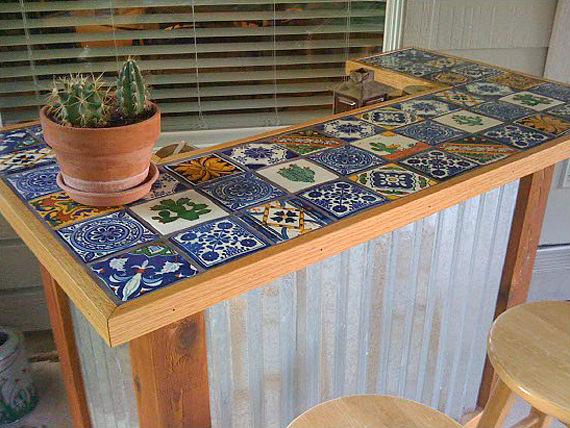
With summer festivities and holidays rushing toward us, there is no better time to stop and think about how you want to enjoy your outdoor space this season. Me? I love Steve’s margaritas… and a glass of wine. A good craft beer in the heat of the summer works too! With outdoor spaces being extensions of the indoors in todays homes, making a DIY bar just seems like a dang good idea. And if you don’t prefer to serve alcohol, use your DIY bar to serve the best iced tea around!
Our featured photo, above, is a tiled outdoor bar from ‘My Carpentry’. It has a full tutorial, with step by step drawings. What a great style for a mediterranean or exotic feel to your garden! I love the corrugated metal, it keeps this project looking updated.
‘Stacked Design’ has a tutorial with tons of photos for this pallet bar/table project. And stools!
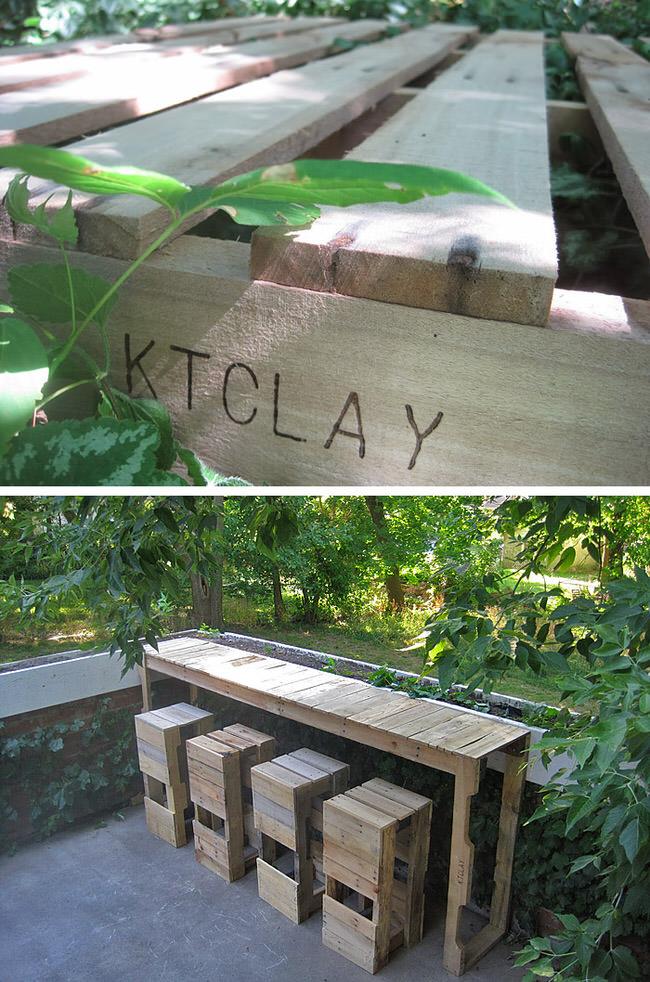
Cleverly Inspired’ shows you how to build an outdoor bar, using their deck railing! Great use of space!
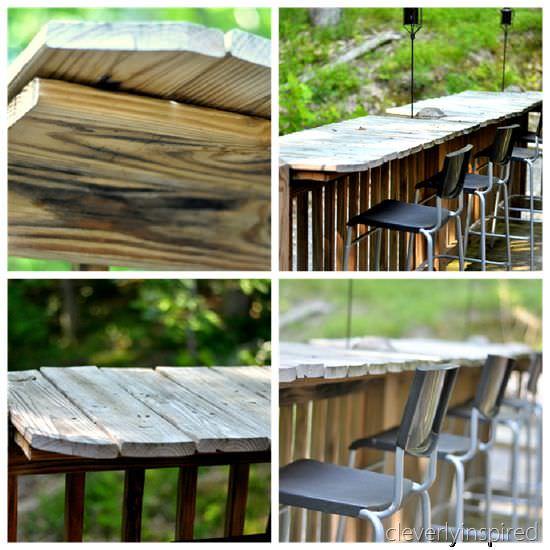
This DIY bar idea by ‘The Wedding Chicks’ is easy, vintage and fun! Just place boards across the rungs of a wood ladder…instant bar!
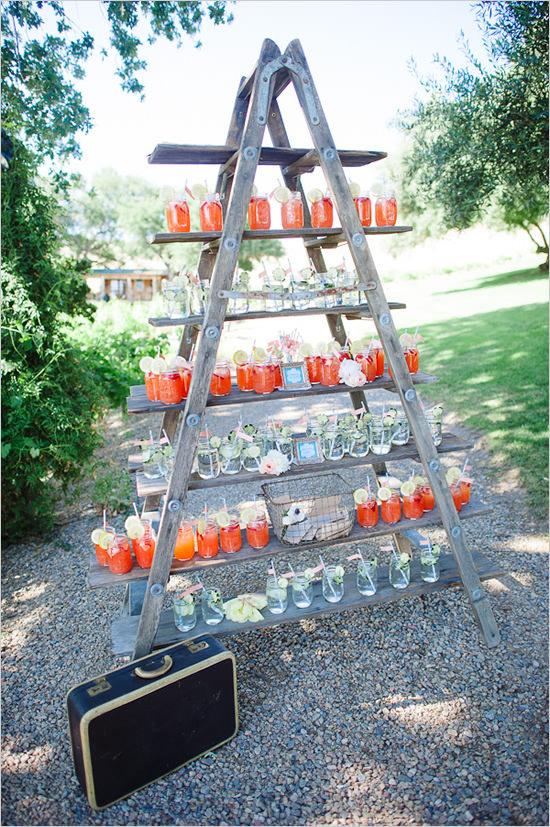
Build a hanging outdoor bar with Sam Henderson from ‘Todays Nest’, for HGTV. This bar was made from old pallets, so its recycling too… great choice for small gardens.

One of our Pinterest finds, using an old hutch as an outdoor bar. Cute and funky! You could pick up a thrift store hutch, then use distressed paint finishes to get this look as well. Be sure to seal it with an exterior grade sealer.
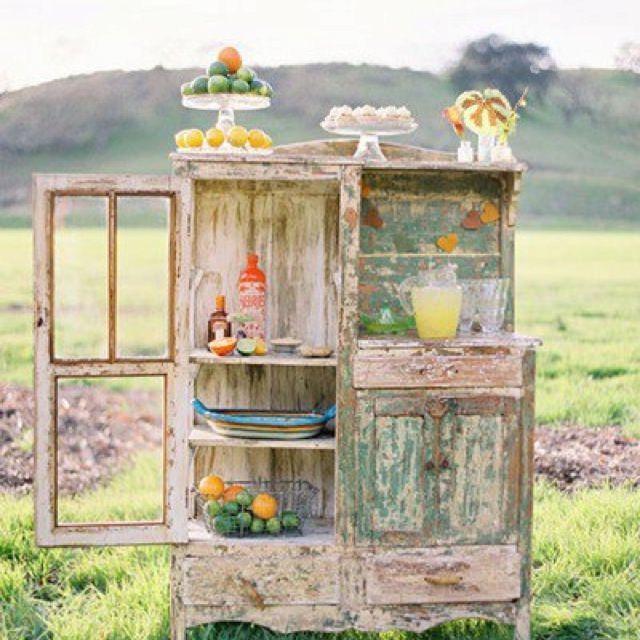
This cinder block planter bar on ‘Design Sponge’ is uber cool, and pretty easy. The basic steps are all there, be sure to read through the comments for additional tips.

Here is an idea that couldn’t be simpler. What more festive way to share drinks than an ice filled wheelbarrow? And, it’s portable! You know, for when the party moves from the patio to the lawn for the inevitable football “game”. From ‘Style Me Pretty‘.
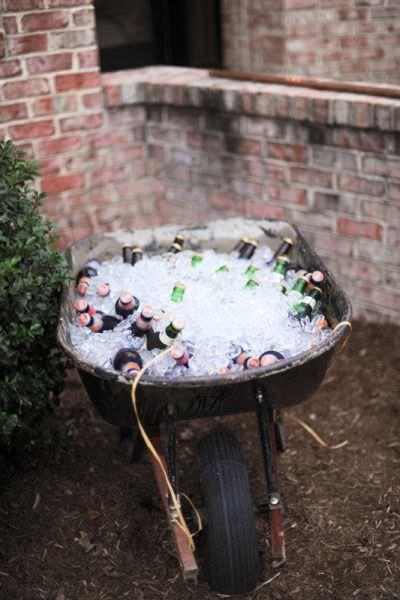
The Creativity Exchange’ has a great project for those who like to “remake” things… their potting bench turned outdoor bar is more than just repurposing. They has a full tutorial on how to add hardware, make glass storage, etc… Great project for those who don’t want to do actual construction.
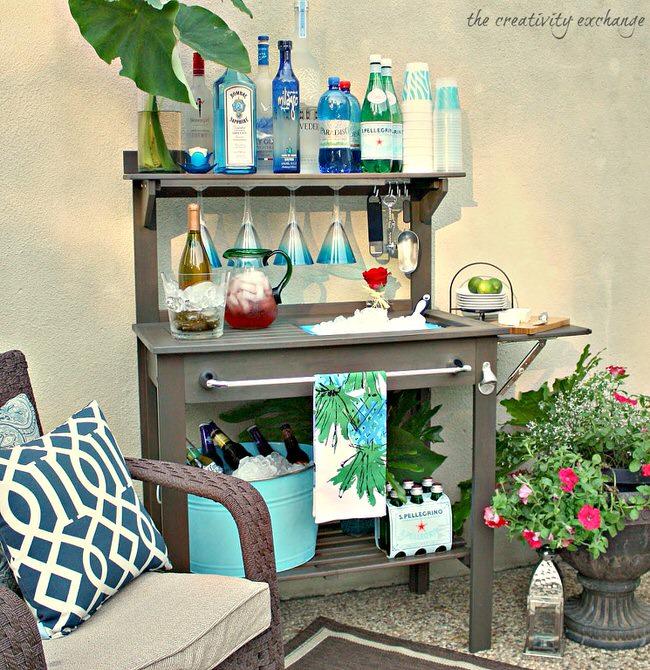
Lastly, another Pinterest inspirational project. This one is pretty easy…attach two pallets together with screws, paint, then top with landscape pavers. Pick up some landscape adhesive at Home Depot and attach the pavers permanently for safety. Done!
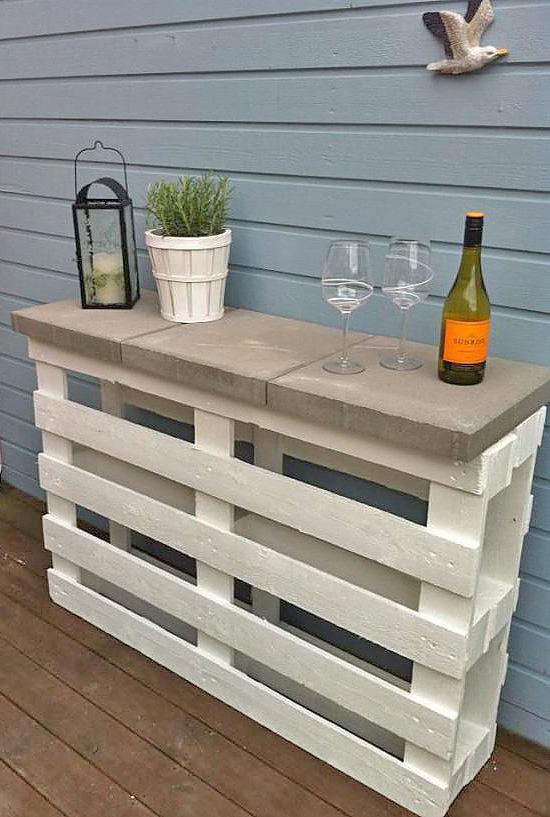
0
0
文章
Selina
2017年05月23日

When designing a container garden there are a few container garden design tips that must be followed to have a beautiful container garden in a limited space.
If you have a container garden, the chances are that it may be a collection of plants than a garden. But if you arrange and organize your container garden rightly, you can create an interesting garden like look and relaxing space in your home.
Container Garden Design Tips1.

When designing a container garden, plant a beautiful shrub or tree in a large unusual or artistic container and place it in a prominent spot in the container garden as a focal point. Plant a low growing plant on its base to create a more alluring effect or leave it alone for dramatic appeal.
2.

Group plants according to their height to create a garden like surrounding effect. To do this, place tall plants and trees in the back and short and low growing plants in front.
3.

Vary plant height with plant stands, or put pots and empty buckets upside down to use as makeshift bases. Create more interest by increasing the number of pots. Place large and heavy pots directly on the ground.
4.

Use pedestal pots or pedestal stands to draw attention to the interesting foliage plants or delicate flowers that might otherwise be overlooked.
5.

Disguise ugly pots and plant stands by placing containers in front of them. This will also create the illusion that the plants are larger than they actually are.
6.

Keep healthy and disease free plants towards the front to create an effect of lush green and colorful container garden.
7.

Plant several plant in a large container instead of planting in many small containers. This will make your container garden more organized and uncluttered. However, don’t buy all the pots of the same size.
8.

Plant hedging and tall plants like bamboo and conifers or grasses in the sides of the container garden to hide view from neighbors. This way you’ll be able to create a more private space and your container garden will look bigger too.
9.

Mix up sculptural plants with plants that have different shapes of leaves to draw attention.
10.

Enhance and beautify the look of pots by matching them with contrasting flowers and foliage plants.
11.

Use spiller, filler, and thriller technique to make beautiful combinations.
If you have a container garden, the chances are that it may be a collection of plants than a garden. But if you arrange and organize your container garden rightly, you can create an interesting garden like look and relaxing space in your home.
Container Garden Design Tips1.

When designing a container garden, plant a beautiful shrub or tree in a large unusual or artistic container and place it in a prominent spot in the container garden as a focal point. Plant a low growing plant on its base to create a more alluring effect or leave it alone for dramatic appeal.
2.

Group plants according to their height to create a garden like surrounding effect. To do this, place tall plants and trees in the back and short and low growing plants in front.
3.

Vary plant height with plant stands, or put pots and empty buckets upside down to use as makeshift bases. Create more interest by increasing the number of pots. Place large and heavy pots directly on the ground.
4.

Use pedestal pots or pedestal stands to draw attention to the interesting foliage plants or delicate flowers that might otherwise be overlooked.
5.

Disguise ugly pots and plant stands by placing containers in front of them. This will also create the illusion that the plants are larger than they actually are.
6.

Keep healthy and disease free plants towards the front to create an effect of lush green and colorful container garden.
7.

Plant several plant in a large container instead of planting in many small containers. This will make your container garden more organized and uncluttered. However, don’t buy all the pots of the same size.
8.

Plant hedging and tall plants like bamboo and conifers or grasses in the sides of the container garden to hide view from neighbors. This way you’ll be able to create a more private space and your container garden will look bigger too.
9.

Mix up sculptural plants with plants that have different shapes of leaves to draw attention.
10.

Enhance and beautify the look of pots by matching them with contrasting flowers and foliage plants.
11.

Use spiller, filler, and thriller technique to make beautiful combinations.
1
0
文章
扭扭
2017年05月23日

Growing strawberries in gutters is the best way to use up your vertical space smartly. Strawberries are super easy fruits to grow in gutters, it also saves them from diseases like crown rot and fruit rot.
You can try to grow strawberries upside down too, learn here.
Things You’ll Need for Growing Strawberries in Gutters
A simple PVC pipe with a diameter of 10 cm., hole saw to make holes. You will also need something to clog pipe from both sides.
1. Step One

Image Credit: ogrodwcentrum
Divide PVC pipes into equal sizes as many you want and make holes according to the size of pipe (approx. 5 cm). Use hole saw to make holes. You’ll also need to make a few hole for drainage on the bottom. Then clog pipe from both sides.
2. Step Two

Image Credit: ogrodwcentrum
Now fill up the soil in the holes you made and plant strawberry plants carefully in each hole. Take care that the crown of strawberry plants should not be covered in soil.
3. Step Three

You can try to grow strawberries upside down too, learn here.
Things You’ll Need for Growing Strawberries in Gutters
A simple PVC pipe with a diameter of 10 cm., hole saw to make holes. You will also need something to clog pipe from both sides.
1. Step One

Image Credit: ogrodwcentrum
Divide PVC pipes into equal sizes as many you want and make holes according to the size of pipe (approx. 5 cm). Use hole saw to make holes. You’ll also need to make a few hole for drainage on the bottom. Then clog pipe from both sides.
2. Step Two

Image Credit: ogrodwcentrum
Now fill up the soil in the holes you made and plant strawberry plants carefully in each hole. Take care that the crown of strawberry plants should not be covered in soil.
3. Step Three

1
0
文章
小马奥
2017年05月23日

If you have a balcony garden, it doesn’t mean you can’t be creative and do something unusual– Here’re some ideas to inspire you!
Creating a garden in a limited space like a balcony can be a challenge, it can be hard to think of creative ideas to keep your balcony garden look great while adhering to the strict confines of working within such a small area. However, a balcony garden need not spell disaster for the keen gardener. Instead, you should take advantage of the challenge and opportunity to create a gardening masterpiece out of your garden in a balcony.

When it comes to balcony gardens, hanging baskets are always a firm favorite. Beautifully-designed hanging baskets offer a universal appeal rarely met by other forms of plant containers, and as such, they have been a constant feature of gardens across the world for many years.

Hanging baskets are simple yet striking – they bring delicate flowers and striking foliage up to eye level, brighten up walls and garden spaces, and are perfect for decorating smaller areas like a BALCONY GARDEN. You can make hanging baskets out of any container available at home!
Also Read: Best Plants for Hanging Baskets
The Universal Appeal of the Hanging Basket
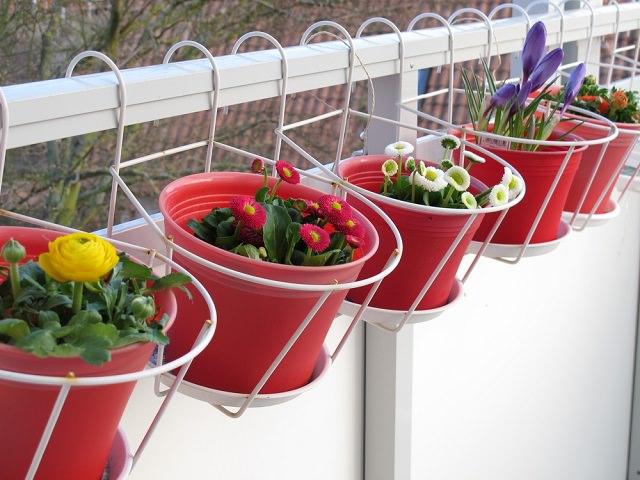
A succession of mini hanging baskets can provide the perfect starter option for those who are just beginning to explore their gardening abilities. Also, the idea of using hanging baskets is perfect for balcony gardeners, this way you can use vertical space of your small garden.
Grow Herbs in Hanging Baskets

Growing herbs, greens, and even cherry tomatoes is possible in hanging baskets.Credit: HGTV
The beauty of the hanging basket is that it can be continually repurposed and remodeled to suit the changing seasons. Whether they are filled with summer or winter flowering plants, hanging baskets are the perfect solution to provide that much-needed injection of color into the overall look of your garden. When it comes to choosing the perfect plants for your hanging basket, you want bright, vibrant trailing plants for the short-term way to wow, or a creative selection of evergreens for a longer lasting option. If you are a fan of growing your own produce, you could also experiment with using a hanging basket as a miniature herb garden, creating the perfect environment to grow fresh herbs in your own garden!
Also Read: How to Start a Balcony Herb Garden
Take the Creative Approach with Ideas

If hanging baskets aren’t really your cup of tea, there are also plenty of other exciting and imaginative ways in which you can decorate your balcony garden.
DIY ladder planter or shelf

Also Read: How to Make a DIY Ladder Shelf
Look for something to Hang Planters

If it is a truly quirky and unique garden that you are after, the key is not to let yourself be confined by traditional ideas of the ideal garden. Let your creativity run wild and do plenty of research to ensure that you pick an approach that works for both you and your balcony garden – after all, who says that small balcony gardens have to be dull and boring?
Tiered Planters are Wonderful Addition

There are also plenty of creative ways in which you can repurpose old items into striking garden containers. Give old or worn-out pieces from your home a new lease of life decorating your balcony garden in style. Everything from old watering cans to worn-out boots to empty paint pots can easily become bold and striking new containers to jazz up the look of your balcony garden. There really are no limits when it comes to finding original ways to use everyday objects in your garden, so get creative and try out some brand new ideas!
Back to Basics with your Balcony Garden
Is your balcony garden still missing that all-important natural, outdoorsy feel?

Not the real lawn but it’s a great idea to include artificial grass as a part of your balcony garden design. Good quality artificial grass can add a natural feel to your garden without the need for a large space or real lawn, affording you the best of both worlds. The installation process of artificial grass is also simple, meaning that it could well be the perfect addition to your garden area. You could also get creative and use artificial grass to cover garden furniture or line planters and hanging baskets to create a truly unique approach.
With so much scope to draw inspiration from, coming up with creative ideas for garden containers should be an easy task. Get creative and don’t be afraid to try out new and exciting ideas – your balcony garden will be looking fantastic in no time at all!
Creating a garden in a limited space like a balcony can be a challenge, it can be hard to think of creative ideas to keep your balcony garden look great while adhering to the strict confines of working within such a small area. However, a balcony garden need not spell disaster for the keen gardener. Instead, you should take advantage of the challenge and opportunity to create a gardening masterpiece out of your garden in a balcony.

When it comes to balcony gardens, hanging baskets are always a firm favorite. Beautifully-designed hanging baskets offer a universal appeal rarely met by other forms of plant containers, and as such, they have been a constant feature of gardens across the world for many years.

Hanging baskets are simple yet striking – they bring delicate flowers and striking foliage up to eye level, brighten up walls and garden spaces, and are perfect for decorating smaller areas like a BALCONY GARDEN. You can make hanging baskets out of any container available at home!
Also Read: Best Plants for Hanging Baskets
The Universal Appeal of the Hanging Basket

A succession of mini hanging baskets can provide the perfect starter option for those who are just beginning to explore their gardening abilities. Also, the idea of using hanging baskets is perfect for balcony gardeners, this way you can use vertical space of your small garden.
Grow Herbs in Hanging Baskets

Growing herbs, greens, and even cherry tomatoes is possible in hanging baskets.Credit: HGTV
The beauty of the hanging basket is that it can be continually repurposed and remodeled to suit the changing seasons. Whether they are filled with summer or winter flowering plants, hanging baskets are the perfect solution to provide that much-needed injection of color into the overall look of your garden. When it comes to choosing the perfect plants for your hanging basket, you want bright, vibrant trailing plants for the short-term way to wow, or a creative selection of evergreens for a longer lasting option. If you are a fan of growing your own produce, you could also experiment with using a hanging basket as a miniature herb garden, creating the perfect environment to grow fresh herbs in your own garden!
Also Read: How to Start a Balcony Herb Garden
Take the Creative Approach with Ideas

If hanging baskets aren’t really your cup of tea, there are also plenty of other exciting and imaginative ways in which you can decorate your balcony garden.
DIY ladder planter or shelf

Also Read: How to Make a DIY Ladder Shelf
Look for something to Hang Planters

If it is a truly quirky and unique garden that you are after, the key is not to let yourself be confined by traditional ideas of the ideal garden. Let your creativity run wild and do plenty of research to ensure that you pick an approach that works for both you and your balcony garden – after all, who says that small balcony gardens have to be dull and boring?
Tiered Planters are Wonderful Addition

There are also plenty of creative ways in which you can repurpose old items into striking garden containers. Give old or worn-out pieces from your home a new lease of life decorating your balcony garden in style. Everything from old watering cans to worn-out boots to empty paint pots can easily become bold and striking new containers to jazz up the look of your balcony garden. There really are no limits when it comes to finding original ways to use everyday objects in your garden, so get creative and try out some brand new ideas!
Back to Basics with your Balcony Garden
Is your balcony garden still missing that all-important natural, outdoorsy feel?

Not the real lawn but it’s a great idea to include artificial grass as a part of your balcony garden design. Good quality artificial grass can add a natural feel to your garden without the need for a large space or real lawn, affording you the best of both worlds. The installation process of artificial grass is also simple, meaning that it could well be the perfect addition to your garden area. You could also get creative and use artificial grass to cover garden furniture or line planters and hanging baskets to create a truly unique approach.
With so much scope to draw inspiration from, coming up with creative ideas for garden containers should be an easy task. Get creative and don’t be afraid to try out new and exciting ideas – your balcony garden will be looking fantastic in no time at all!
0
0
文章
扭扭
2017年05月23日

Want to grow so many strawberries in so little space? Try one of these vertical DIY ideas for growing strawberries!
The fresh and juicy strawberries are one of the best fruits you can grow in containers
Also Read: How to Grow Strawberries
1. Vertical Strawberry Tube Planter
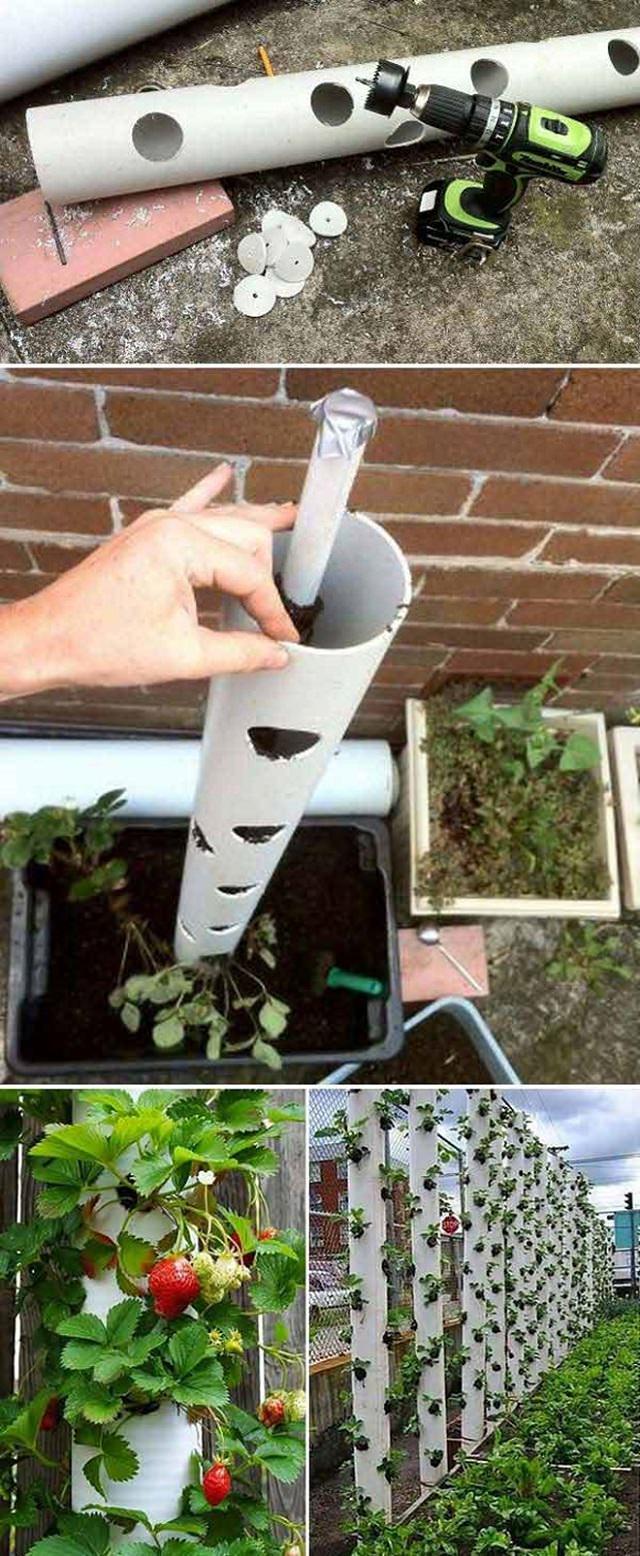
Ordinary PVC pipes are used for growing tons of strawberry plants in a small space, unbelievable. When you lack an appropriate garden space or yard, a vertical gardening idea like this can be tried. All you need for this DIY idea is a few PVC pipes, a drilling machine, and of course, some gardening essentials. Just keep in mind that vertical units require careful watering, so the last thing you would want is for them to dry out. The tutorial is available here!
2. Vertical Pyramid Planter

Go vertical, if you lack enough room to plant. A strawberry tower planter gives you the additional planting and growing space you need to showcase your love for this much-loved fruit. It’s an unusual and functional DIY garden project you can try. See the step by step DIY article here!
3. Hanging Basket

Growing strawberries in hanging baskets is possible and easy enough. An average-sized basket can fit a few strawberry plants. So, all you have to do is fill it up with the right rich potting soil and water regularly. That’s it! Check out the DIY tutorial on this site.
Also Read: The Right Time to Plant Strawberries
4. Strawberry Pallet Planter

A strawberry pallet planter is a clever idea to grow plants like strawberries that spread through runners; it also improves the productivity of this fruit. Pallets are cheap and sturdy; you can use them to create a raised bed like structure. Must see the tutorial post here!
5. Hanging Strawberry Planters

Growing strawberries up in the air in hanging containers is a simple and easy way to grow a lot of plants in a little to no space. Choose some big tin cans as a planter, also some cool color paint. This perfect idea of recycling used TIN CANS can be found here.
6. Strawberry Tower

A strawberry tower with an in-built reservoir is an excellent and unique way to grow juicy and fresh strawberries when you’re short of space. Easy to maintain, it is made of an array of plastic pots stacked up one on top of each other in the form of a tower. Also, the inbuilt reservoir makes watering a lot easier. This fantastic step by step DIY idea is curated from A Piece of Rainbow.
7. Strawberry Gutter Garden

Strawberries are super easy fruits to grow in gutters; it also saves them from diseases like crown rot and fruit rot. Also, this you can grow so many plants. See the step by step DIY idea with pictures here.
8. Stepped Strawberry Ladder
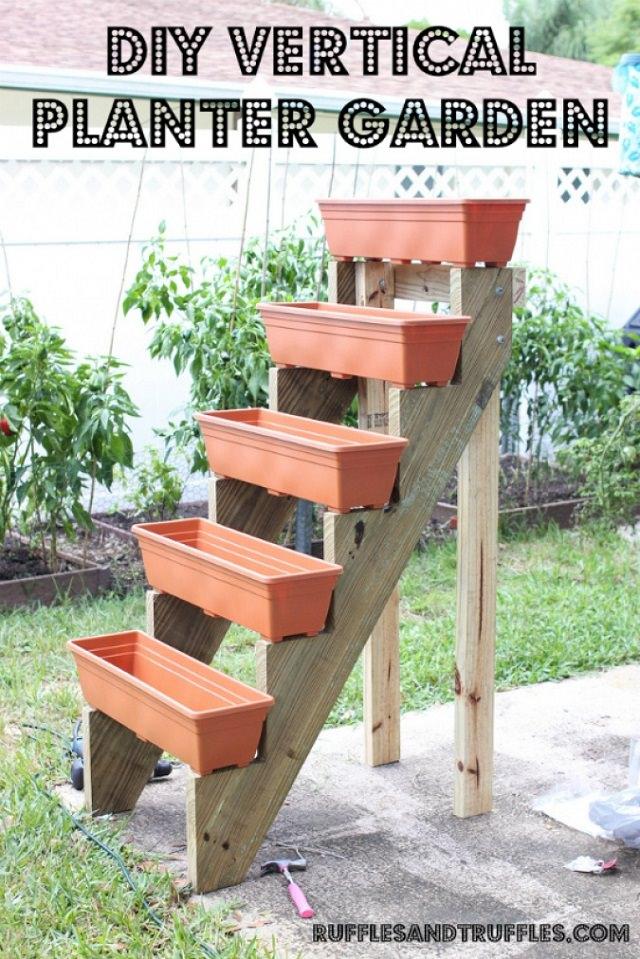
Not only the strawberries but you can also grow vegetables and herbs following this smart idea. You will need some help with the assembly process, though, as this is one of those DIY ideas for growing strawberries that need considerable effort. Once the structure is complete, fill up the planter boxes with the correct potting soil, seedlings and then watch them grow. The step by step article is available here.
Also Read: Vertical Garden Ideas for Small Gardens
9. A Strawberry Jar

A strawberry jar is a fun way to plant strawberries. After all, what is more, appealing than a nicely painted jar brimming with lush, green suckers and deep red berries. The one thing that makes these jars unique is that they have holes on their sides in addition to the top. This facilitates easy watering and proper care. To increase variety, plant another ornamental or edible plant, such as thyme or cilantro along with the strawberries, if you like. Click here to learn more this DIY idea.
The fresh and juicy strawberries are one of the best fruits you can grow in containers
Also Read: How to Grow Strawberries
1. Vertical Strawberry Tube Planter

Ordinary PVC pipes are used for growing tons of strawberry plants in a small space, unbelievable. When you lack an appropriate garden space or yard, a vertical gardening idea like this can be tried. All you need for this DIY idea is a few PVC pipes, a drilling machine, and of course, some gardening essentials. Just keep in mind that vertical units require careful watering, so the last thing you would want is for them to dry out. The tutorial is available here!
2. Vertical Pyramid Planter

Go vertical, if you lack enough room to plant. A strawberry tower planter gives you the additional planting and growing space you need to showcase your love for this much-loved fruit. It’s an unusual and functional DIY garden project you can try. See the step by step DIY article here!
3. Hanging Basket

Growing strawberries in hanging baskets is possible and easy enough. An average-sized basket can fit a few strawberry plants. So, all you have to do is fill it up with the right rich potting soil and water regularly. That’s it! Check out the DIY tutorial on this site.
Also Read: The Right Time to Plant Strawberries
4. Strawberry Pallet Planter

A strawberry pallet planter is a clever idea to grow plants like strawberries that spread through runners; it also improves the productivity of this fruit. Pallets are cheap and sturdy; you can use them to create a raised bed like structure. Must see the tutorial post here!
5. Hanging Strawberry Planters

Growing strawberries up in the air in hanging containers is a simple and easy way to grow a lot of plants in a little to no space. Choose some big tin cans as a planter, also some cool color paint. This perfect idea of recycling used TIN CANS can be found here.
6. Strawberry Tower

A strawberry tower with an in-built reservoir is an excellent and unique way to grow juicy and fresh strawberries when you’re short of space. Easy to maintain, it is made of an array of plastic pots stacked up one on top of each other in the form of a tower. Also, the inbuilt reservoir makes watering a lot easier. This fantastic step by step DIY idea is curated from A Piece of Rainbow.
7. Strawberry Gutter Garden

Strawberries are super easy fruits to grow in gutters; it also saves them from diseases like crown rot and fruit rot. Also, this you can grow so many plants. See the step by step DIY idea with pictures here.
8. Stepped Strawberry Ladder

Not only the strawberries but you can also grow vegetables and herbs following this smart idea. You will need some help with the assembly process, though, as this is one of those DIY ideas for growing strawberries that need considerable effort. Once the structure is complete, fill up the planter boxes with the correct potting soil, seedlings and then watch them grow. The step by step article is available here.
Also Read: Vertical Garden Ideas for Small Gardens
9. A Strawberry Jar

A strawberry jar is a fun way to plant strawberries. After all, what is more, appealing than a nicely painted jar brimming with lush, green suckers and deep red berries. The one thing that makes these jars unique is that they have holes on their sides in addition to the top. This facilitates easy watering and proper care. To increase variety, plant another ornamental or edible plant, such as thyme or cilantro along with the strawberries, if you like. Click here to learn more this DIY idea.
1
1
文章
小马奥
2017年05月23日

Learn about the Best Plants For Hanging Baskets. Hanging baskets filled with colorful flowers and plants are very showy and elegant and adorn any garden. You don’t need a lot of space to display them, too!A variety of flowers and plants can be grown in hanging baskets. The choice of plants in baskets depends on both the size of the basket and the growing conditions where the basket has to be placed. The baskets, which are kept in the shade and less windy space are easier to look after as they require less watering.Nasturtium

If you are looking for a quick growing and low maintenance plant, nasturtium is the plant you should consider. The trailing varieties of nasturtium work especially well and it is one of best plants for hanging baskets. Nasturtium loves the warmth and sun, though they can tolerate partial shade. They prefer poor soil and doesn’t need much fertilizer.
Petunia

Petunia is one of the most popular flowers and best plant for hanging the basket. It covers hanging basket quickly and blooms profusely. There are many varieties of petunias that come in myriads of colors including black.
Tomatoes

Growing tomatoes (cherry tomatoes) in hanging baskets is an apt way to use vertical space, plus they adapt easily unlike other vegetables. Basically, your success in growing tomatoes depends on three factors— yours choosing right variety, basket, and providing it appropriate conditions, if you satisfy all of the three, you’ll get rich homegrown tomatoes in harvesting season. Learn how to grow tomatoes in a hanging basket.
Also Read: How to Grow Tomatoes on a Balcony
Portulaca

Portulaca or moss rose is an excellent trailing ground cover plant, not only the colorful flowers, its needle-like succulent foliage looks wonderful too. This tropical beauty can be grown as an annual plant in non-tropical places and as a perennial in tropics in both containers and hanging baskets.
Begonia

Begonias are the perfect plant for shady places. It blooms continuously in summer and fall and in shades of pink, red and white. The best Begonias for hanging baskets are trailing varieties. Begonias require moist soil, however, you shouldn’t not over water begonias, as the plant is susceptible to root rot.
Philodendron and Spider Plant

Both the spider plant and species of philodendron are considered as houseplants, but they can also be grown outdoors in protected conditions. They do better when grown alone in a hanging planter. Spider plant forms a rosette or grouping of the bush like light green and white variegated foliage.
Philodendrons have solidly light green or variegated, waxy, heart-shaped leaves and have a vine like growing habit. They require indirect sunlight and grow well in the shade outdoors or in low light, indoors.
Diascia

Diascia is another hanging basket plant that you can grow. This short-lived perennial is often grown as an annual, it is hardy in warmer zones (USDA Zones 9-11), however, some varieties are hardy down to Zone 7. Its beautiful colorful flowers are rather small, of bright colors and appear in clusters from spring to fall.
Geranium

The Geranium is another plant that can be grown in baskets. Both the foliage and flowers are beautiful. Geraniums prefer a sunny spot and well-draining soil to flower.
Verbena

It is possible to grow verbena in a hanging basket, this sun-loving plant is suitable for South facing places. Verbenas come in a variety of colors and shades including pink, purple, white, red and lavender etc. The cluster of flowers blooms continuously throughout the summer in a cold climate. Whereas, in tropics verbenas are perennial.
Fuchsia

Fuchsia is an elegant and colorful flowering hanging basket plant that prefers shade and cool summers. Flowers from over 120 varieties of fuchsia plants can grow to a length of 4 inches. The trailing stems cascade out over the hanging basket with a mass of colorful flowers. Fuchsia flowers are often deep pink or orange with purple or white vibrant trimmings.
Impatiens

The impatiens grow best in shade space and in moist soil. It comes in a variety of colors including salmon, cherry, pink, white and lavender. If growing in baskets, apply a balanced fertilizer in every two to three weeks. Impatiens grow very easily from seed and cuttings.
Dianthus

Dianthus comes in over 300 varieties and usually grown as an annual. This well-known flower is good for borders, ground covers, for cut flowers and several species are compact enough for planting in the hanging baskets, offering a profusion of flowers during the summer.
Ivy

Evergreen, perennial plant, ivy comes with a variety of leaf shapes and variegated foliage types. It is a perfect plant that provides a background for the gaudiest colors. It trails gracefully in hanging baskets. Most ivy varieties thrive inside the home, as they do not require direct sunlight and only need minimal care. However, it grows outside easily in shade.
Pansy

Pansies are a fast growing plant that provides masses of beautiful flowers during the summer in many shades. Deadhead them to extend bloom time.
Lobelia

One of the best flowers that grows easily in containers. Popular for the colors. The leaves are small, smooth, shiny and tiny flowers appear in blue, purple, pink or white. It blooms all summer long. Abundant and long flowering is promoted by regular trimming of withered shoots.
Sweet Alyssum

Sitting near a sweet alyssum hanging basket is a joy. This amazing fragrant flower is perfect for balcony and roof top gardens. The trailing habit makes it is a perfect plant for hanging baskets.
Lantana

Small weeping varieties are more suitable for hanging baskets shrubby ones. The lantana flowers are fragrant, colorful, pleasing, attract pollinators but invasive perennial in warm frost free areas. But in hanging baskets or in pots they are controllable. You can also grow lantana in colder regions as an annual.
Also Read: How to Grow Lantana
Calibrachoa

Also called “Million Bells”, this beautiful cousin of petunia is more suitable for hanging baskets than petunias and more durable to changing weather conditions and diseases. It can grow up to 8 inches tall. The plant produces blooms all summer long and in fall in moderate climates until the first frost. Whereas in tropics, it blooms in winter and spring.
Also Read: Calibrachoa Care
Nemesia

Nemesia is one of the easiest annuals that you can grow in both pots and in hanging baskets. It is a hardy perennial in USDA Zones 9-10. Its flowers are double-lipped with a spur in small pansy-like appearance and lobelia-like size.

If you are looking for a quick growing and low maintenance plant, nasturtium is the plant you should consider. The trailing varieties of nasturtium work especially well and it is one of best plants for hanging baskets. Nasturtium loves the warmth and sun, though they can tolerate partial shade. They prefer poor soil and doesn’t need much fertilizer.
Petunia

Petunia is one of the most popular flowers and best plant for hanging the basket. It covers hanging basket quickly and blooms profusely. There are many varieties of petunias that come in myriads of colors including black.
Tomatoes

Growing tomatoes (cherry tomatoes) in hanging baskets is an apt way to use vertical space, plus they adapt easily unlike other vegetables. Basically, your success in growing tomatoes depends on three factors— yours choosing right variety, basket, and providing it appropriate conditions, if you satisfy all of the three, you’ll get rich homegrown tomatoes in harvesting season. Learn how to grow tomatoes in a hanging basket.
Also Read: How to Grow Tomatoes on a Balcony
Portulaca

Portulaca or moss rose is an excellent trailing ground cover plant, not only the colorful flowers, its needle-like succulent foliage looks wonderful too. This tropical beauty can be grown as an annual plant in non-tropical places and as a perennial in tropics in both containers and hanging baskets.
Begonia

Begonias are the perfect plant for shady places. It blooms continuously in summer and fall and in shades of pink, red and white. The best Begonias for hanging baskets are trailing varieties. Begonias require moist soil, however, you shouldn’t not over water begonias, as the plant is susceptible to root rot.
Philodendron and Spider Plant

Both the spider plant and species of philodendron are considered as houseplants, but they can also be grown outdoors in protected conditions. They do better when grown alone in a hanging planter. Spider plant forms a rosette or grouping of the bush like light green and white variegated foliage.
Philodendrons have solidly light green or variegated, waxy, heart-shaped leaves and have a vine like growing habit. They require indirect sunlight and grow well in the shade outdoors or in low light, indoors.
Diascia

Diascia is another hanging basket plant that you can grow. This short-lived perennial is often grown as an annual, it is hardy in warmer zones (USDA Zones 9-11), however, some varieties are hardy down to Zone 7. Its beautiful colorful flowers are rather small, of bright colors and appear in clusters from spring to fall.
Geranium

The Geranium is another plant that can be grown in baskets. Both the foliage and flowers are beautiful. Geraniums prefer a sunny spot and well-draining soil to flower.
Verbena

It is possible to grow verbena in a hanging basket, this sun-loving plant is suitable for South facing places. Verbenas come in a variety of colors and shades including pink, purple, white, red and lavender etc. The cluster of flowers blooms continuously throughout the summer in a cold climate. Whereas, in tropics verbenas are perennial.
Fuchsia

Fuchsia is an elegant and colorful flowering hanging basket plant that prefers shade and cool summers. Flowers from over 120 varieties of fuchsia plants can grow to a length of 4 inches. The trailing stems cascade out over the hanging basket with a mass of colorful flowers. Fuchsia flowers are often deep pink or orange with purple or white vibrant trimmings.
Impatiens

The impatiens grow best in shade space and in moist soil. It comes in a variety of colors including salmon, cherry, pink, white and lavender. If growing in baskets, apply a balanced fertilizer in every two to three weeks. Impatiens grow very easily from seed and cuttings.
Dianthus

Dianthus comes in over 300 varieties and usually grown as an annual. This well-known flower is good for borders, ground covers, for cut flowers and several species are compact enough for planting in the hanging baskets, offering a profusion of flowers during the summer.
Ivy

Evergreen, perennial plant, ivy comes with a variety of leaf shapes and variegated foliage types. It is a perfect plant that provides a background for the gaudiest colors. It trails gracefully in hanging baskets. Most ivy varieties thrive inside the home, as they do not require direct sunlight and only need minimal care. However, it grows outside easily in shade.
Pansy

Pansies are a fast growing plant that provides masses of beautiful flowers during the summer in many shades. Deadhead them to extend bloom time.
Lobelia

One of the best flowers that grows easily in containers. Popular for the colors. The leaves are small, smooth, shiny and tiny flowers appear in blue, purple, pink or white. It blooms all summer long. Abundant and long flowering is promoted by regular trimming of withered shoots.
Sweet Alyssum

Sitting near a sweet alyssum hanging basket is a joy. This amazing fragrant flower is perfect for balcony and roof top gardens. The trailing habit makes it is a perfect plant for hanging baskets.
Lantana

Small weeping varieties are more suitable for hanging baskets shrubby ones. The lantana flowers are fragrant, colorful, pleasing, attract pollinators but invasive perennial in warm frost free areas. But in hanging baskets or in pots they are controllable. You can also grow lantana in colder regions as an annual.
Also Read: How to Grow Lantana
Calibrachoa

Also called “Million Bells”, this beautiful cousin of petunia is more suitable for hanging baskets than petunias and more durable to changing weather conditions and diseases. It can grow up to 8 inches tall. The plant produces blooms all summer long and in fall in moderate climates until the first frost. Whereas in tropics, it blooms in winter and spring.
Also Read: Calibrachoa Care
Nemesia

Nemesia is one of the easiest annuals that you can grow in both pots and in hanging baskets. It is a hardy perennial in USDA Zones 9-10. Its flowers are double-lipped with a spur in small pansy-like appearance and lobelia-like size.
0
1
文章
Gina
2017年05月23日

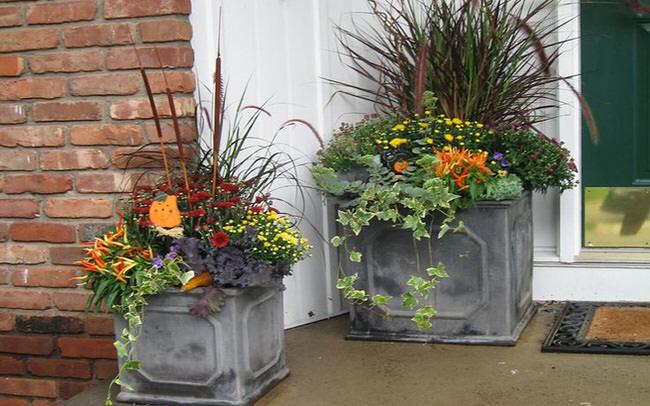
The growing session isn’t over just because summer is winding down… one of the best ways to keep your garden space vibrant is to use fall containers. And most of you who have been reading TGG awhile know that I like to do things just a little different from the crowd, so our choices here are not the average pot o’ mums! So with inspiring combinations and plant suggestions, let’s let the photos (ok, and a few suggestions from us!) do the talking! Fabulous fall containers!
First, some tips…
1. Use grasses. Height, texture, movement… and they look great all winter. (Before you ask, this one is ‘Pennisetum’ “Fireworks”.)

2. Use Kale. Pretty! And, it lasts right through frost, and even snow! Look for larger, colorful varieties at your nursery. Don’t buy the 4 inch pots from the grocery store nursery section. Big difference.
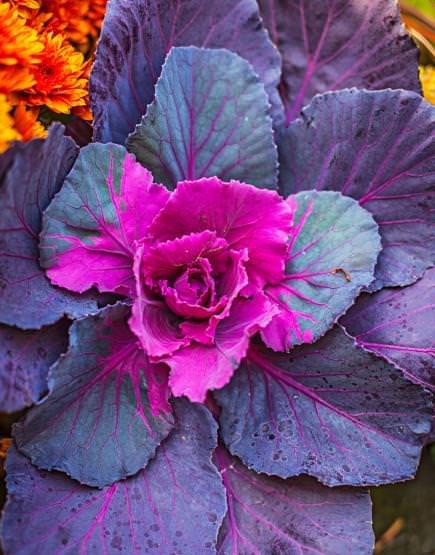
3. Use something other than plants to take it out of the “snooze” zone. An unusual container, adding pumpkins or squash to the container, using branches or other natural items as “accessories”… This also allows you to buy far fewer plants by filling space with other things of interest.
4. Don’t stop watering/ fertilizing…
5. Pack ’em in tight, because they won’t have a long, warm season of fast growth to fill in.Now, on with the inspiration!
From landscape designer Deborah Silver, and her blog ‘Dirt Simple‘, these two fall containers epitomize the use of grasses, kale and unusual containers… Check out her blog, they do amazing work! A bunch of inspiring photos!

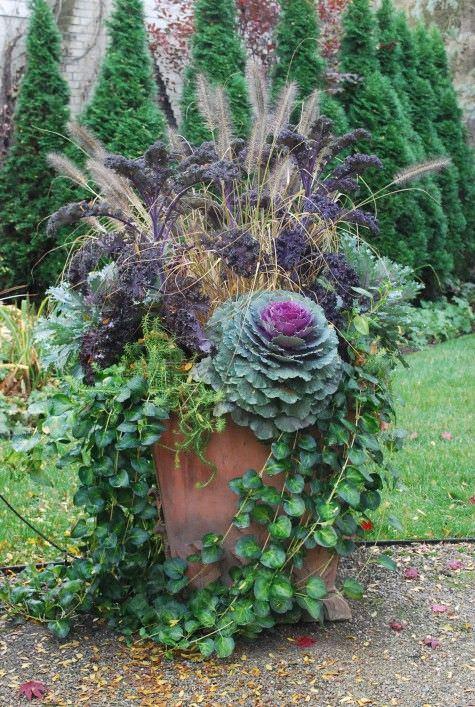
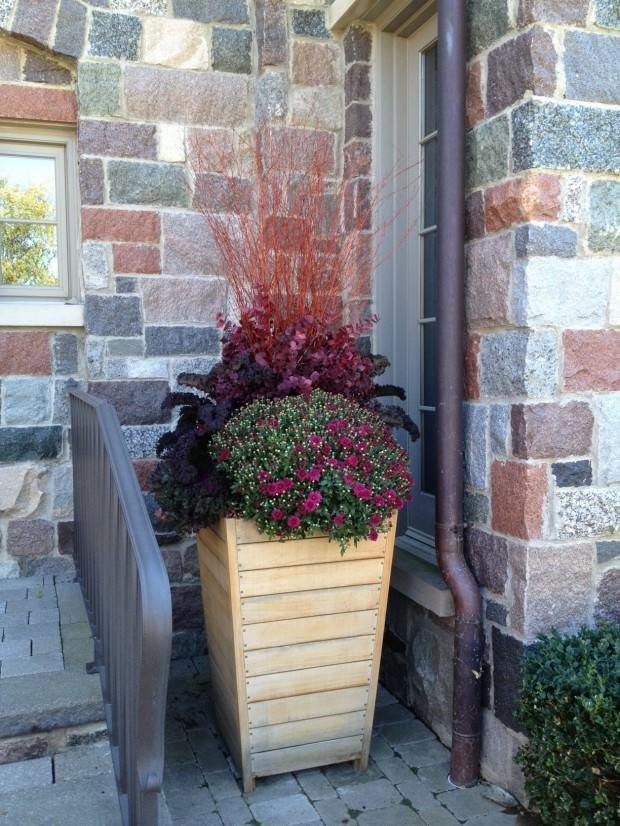
From ‘VSF, New York‘, this florist created basket container is the coolest thing around. Branches, moss and a pumpkin keep company with Kale and Mums… anything but ordinary!
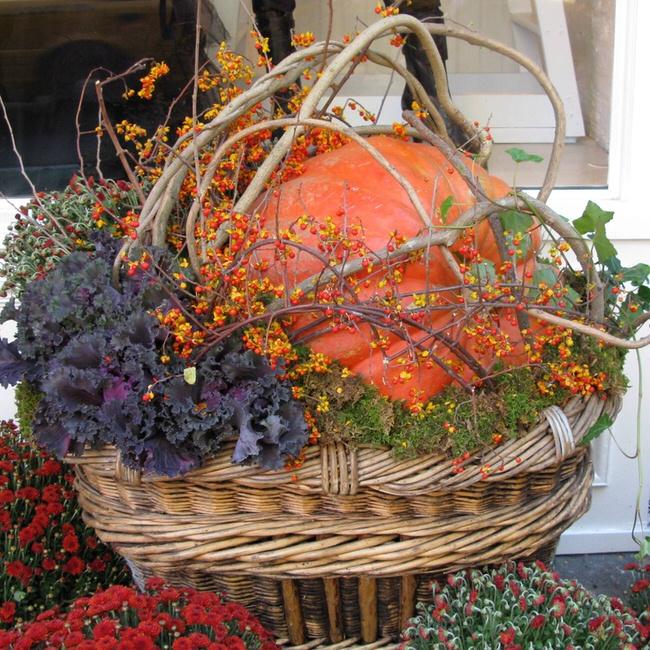
From ‘BHG’, three plants, simple container, easy to duplicate!
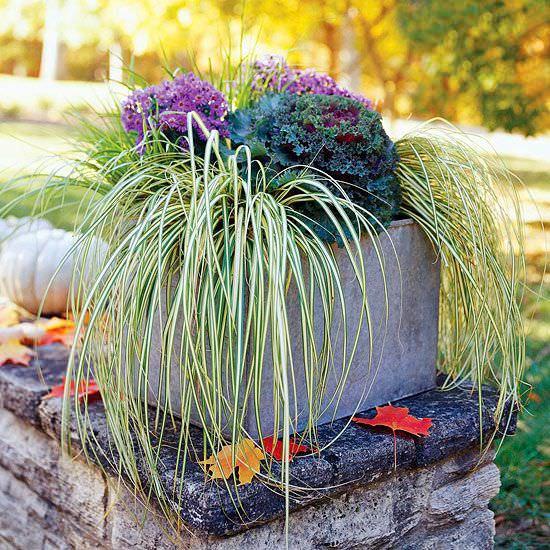
Lucy at ‘Craftberry Bush‘ did an amazing job on her fall front porch! Check out her use of grasses, containers, Kale and pumpkins… Really professional job!
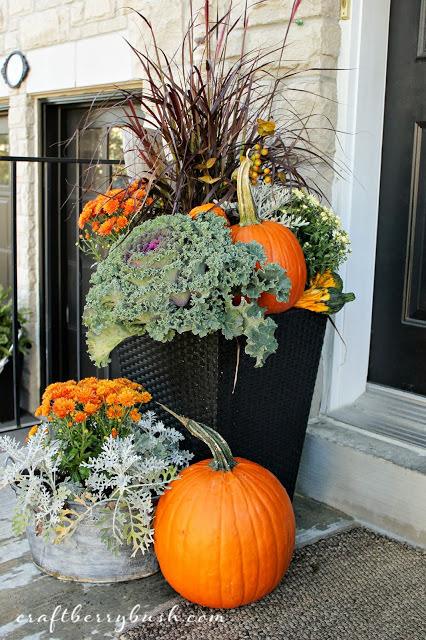
Another simple design, by ‘Midwest Living’…
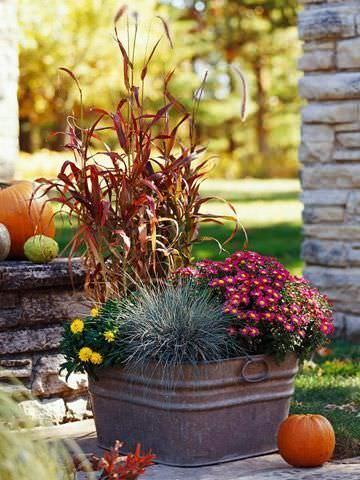
From ‘Canadian Gardening‘, this unusual fall window box has my vote for one of a kind! Love the eerie branches!
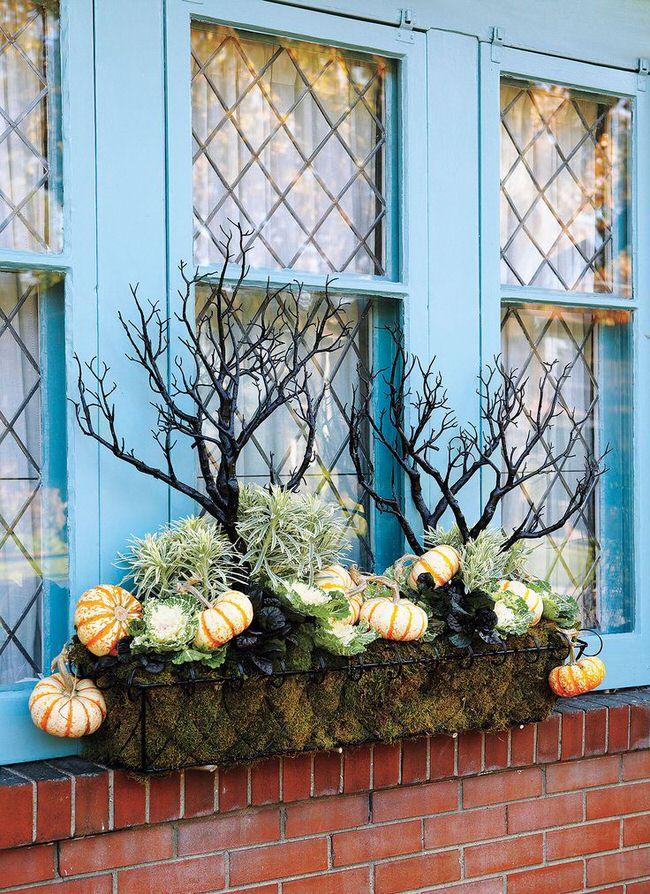
Use a “Flower Tower” planter, (or DIY one from this video by Home Depot) to grow Kale! Creative!
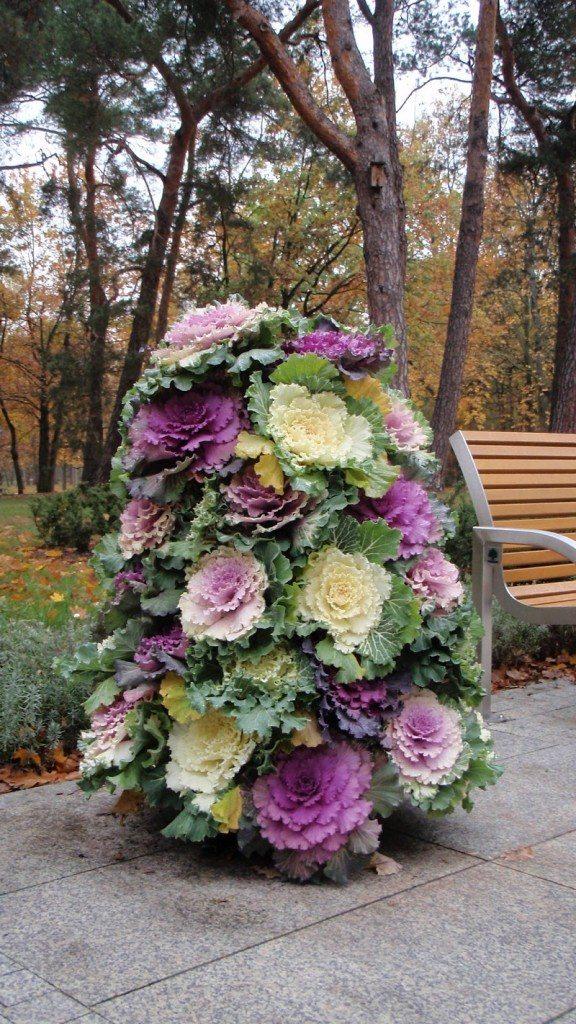
This homeowner used a tall branch to add height and substance, one licorice plant, and a pumpkin… Love the simpleness, yet so interesting!
Finally, from ‘Pocket Full of Posies Design‘, this planting uses unusual containers to make this mum and grasses front door container really wow.

1
0
文章
Hande Salcan
2017年05月23日


The early spring might be the best time of year to get out and organize your garden shed… The best part is that it gets you out in the garden, even though there is little to do in the way of planting and caring for your garden space. Oh, yea, it also saves you time, money and aggravation. But really, it gets you out in the garden, and when can that ever be a bad thing?
Seriously, getting your garden shed organized will make a big difference once the growing season is in full swing. You won’t spend hours looking for that twine to tie up the beans, you won’t run out to buy an expensive new rake, only to find the perfectly serviceable old one in the back of the shed behind the mower, and you most of all, it will allow you to utilize your precious gardening time for just that…gardening! So use these tips and ideas to organize your garden shed or space!
The way I see it, you can do this in three steps…
Step one – Organize the big stuff!
For your large tools, keeping them from falling all over the floor, or even hurting someone is key. This is a DIY solution to tool storage. Cut pieces of scrap PVC pipe into sections, then screw into the wall as shown. Label if desired. Find the tutorial here at AshBee Design.

Gardenista shows us how to round up a garden shed with a roll of velcro!

And also, using a peg system to store your gardening tools on the wall.
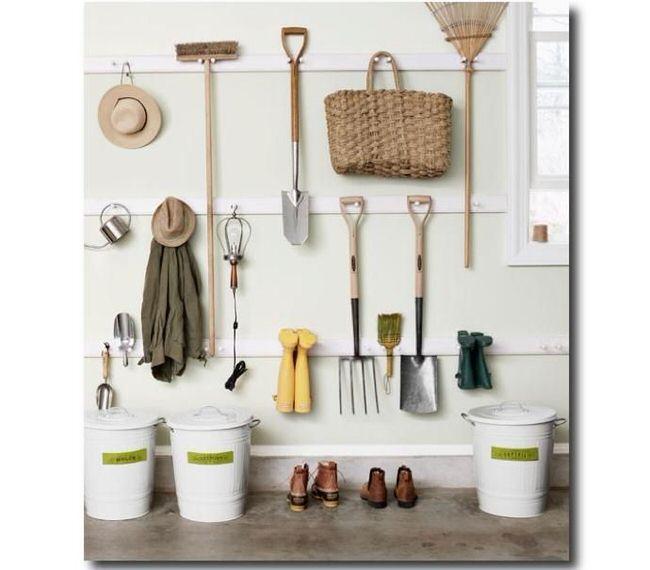
Step two- Organize the small stuff!
Using an old toilet paper holder to keep string and twine right where you left it… clever!
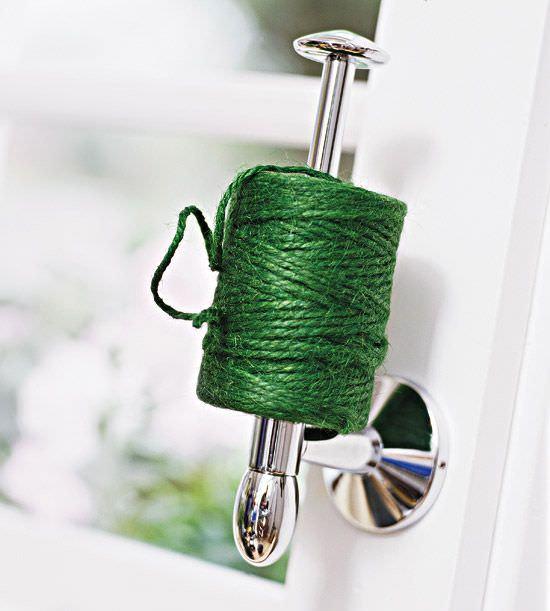
Use old crates to create shelving and storage areas. This is really useful where you cannot attach storage to a wall, like around a window.

From Our Little Acre, again using recycled wood, this pallet project for garden shed storage is so smart and creative. You could add as many hooks as you needed for all your hand tools.

Step Three- Organize the process! What do I mean by that? Get your head in the game… For example…
Use ribbon and clothespins to to keep track of the garden chores by month… Thanks BHG !

Finally, keep a calendar in your garden shed… and not just to keep track of the chores! Mark down when your lilacs bloomed this year, whether the zinnias looked good next to the zebra grass, and what week in July the potato beetles attacked. Few of us remember to write these things down once we get back to the house, and this kind of information can be invaluable to a gardener. Oh, and yes, you should also write down the chores. ;)
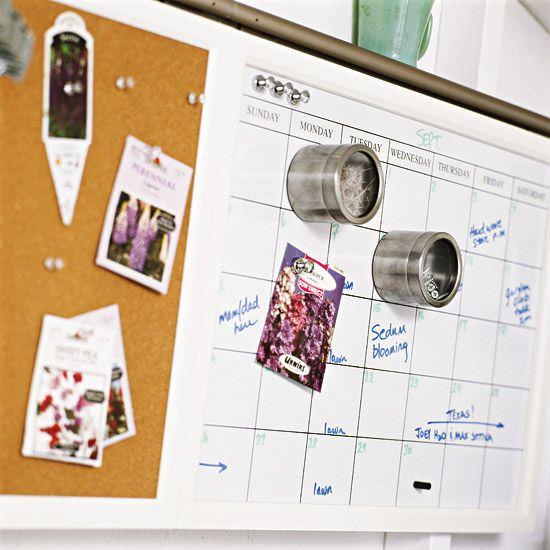
0
3
文章
Micky
2017年05月23日


Sometimes when decking out the halls, we forget that the garden needs some Christmas love too! After all, he was born in a manger, with the animals and the cold… not in a warm cozy inn! So isn’t it fitting we treat our outdoor space with some Christmas decorations? These DIY front yard Christmas decorating projects will make the season special in your garden, and for all those who pass by it! Our featured photo above comes from ‘HGTV’. They show you how to dress up trees with moravian stars.
Also from ‘HGTV’, make a simple wooden Christmas tree with reclaimed wood! Easy tutorial…

Make these glowing gift boxes by ‘Martha’, and give the gift that keeps on giving! Holiday spirit!

If you live in an area that freezes hard at Christmas, these frozen ice luminaries are an amazing way to light the garden path. Do it for a party, or just for your family! SOOOOO pretty! These first ones are from ‘Henhurst Interiors‘, and here’s what they said on making them… “Beautiful way to welcome guests to your party–illuminate your entry with luminaries made from frozen ice. Use half gallon milk cartons and empty wine bottles. After initial freeze, remove wine bottle and add more water to raise bottom level to accommodate a votive candle.”…

If that isn’t clear enough, ‘BHG’ offers you a full video on how to make ice luminarias.

This I’ve never seen, but love! Make these snow lanterns with the help of ‘Little Green Fingers’… Easy, just requires lot’s of snowballs! Great way to burn off some energy with the whole family, making a snowball pile for your creations.

Make rustic nail head Christmas trees with this tutorial from ‘HGTV’… I’d love a forest of these!

Last year we tried to create a magical forest scene with lights in our front yard… These DIY tomato cage Christmas trees would have been the thing to make it perfect! From ’17 Apart’…

Want a simple look? Make these scrap wood Christmas trees by ‘Restyled Junk’. Quick tutorial on how to make these happen.

‘Finding Home’ “found” the perfect Christmas decorating project… a reindeer! I love that this reclaimed wood reindeer isn’t too cutesy, but they don’t leave out the red nose. Gotta have some magic, people!

Last, we have this rustic log slice snowman by ‘Grandparents Plus‘. I couldn’t find a tutorial for it, but it looks pretty simple in design. Flatten the log slice edges where you attach for a tight fit,( and so they won’t tip over!) then screw from the back or use wood glue and clamps.

That’s it! Do you have any DIY front yard Christmas decorations that you use or make every year? Share in comments!
0
0




